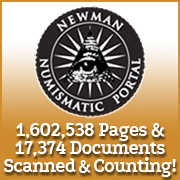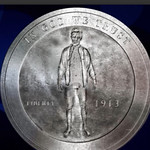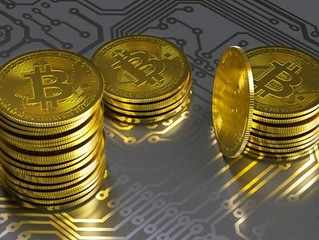
About UsThe Numismatic Bibliomania Society is a non-profit organization devoted to the study and enjoyment of numismatic literature. For more information please see our web site at coinbooks.org SubscriptionsThose wishing to become new E-Sylum subscribers (or wishing to Unsubscribe) can go to the following web page link MembershipThere is a membership application available on the web site Membership Application To join, print the application and return it with your check to the address printed on the application. Print/Digital membership is $40 to addresses in the U.S., and $60 elsewhere. A digital-only membership is available for $25. For those without web access, write to: Terry White, Treasurer AsylumFor Asylum mailing address changes and other membership questions, contact Terry at this email address: terrywhite5475@yahoo.com SubmissionsTo submit items for publication in The E-Sylum, just Reply to this message, or write to the Editor at this address: whomren@gmail.com BUY THE BOOK BEFORE THE COINSale Calendar |
- WAYNE'S WORDS: THE E-SYLUM DECEMBER 24, 2017
- NEW BOOK: COINGATE
- BOOK REVIEW: TRENCH ART
- COINS & CHRISTMAS PUDDING ON THE PORTAL
- NEWMAN PORTAL SEARCH: ISAAC EXCELL
- SANTA AND COLONIAL COINS ON THE NEWMAN PORTAL
- CHRISTMAS CLUB TOKENS
- NOTES FROM E-SYLUM READERS: DECEMBER 24, 2017
- JEFF ROCK REMEMBERS RICH HARTZOG
- VOCABULARY TERM: JACK DIE
- ISAAC EXCELL (1846-1925)
- ARTICLE PROFILES THE ALASKA MINT
- BANKNOTE ENGRAVER ROBERT SAVAGE INFO SOUGHT
- NUMISMATIC NUGGETS: DECEMBER 24, 2017
- JANUARY 2018 STACK’S BOWERS SALE HIGHLIGHTS
- JANUARY 2018 HERITAGE PAPER MONEY SALE HIGHLIGHTS
- MORE ON THE 1894 BRITISH HONDURAS NOTES
- UNISSUED EDWARD VIII NOTES HIGHLIGHT REGINA SHOW
- THE MYSTERY OF MAINE’S VIKING PENNY
- TRUMP UNVEILS CHALLENGE COIN
- PIGEON'S DICKIN MEDAL FETCHES £8000
- 2017 ARMENIA HYBRID COTTON-POLYESTER BANKNOTE
- RUSSIAN VIDEO PROMOTES BANKNOTE USE
- GERMAN BANKER COUNTS 1.2M PFENNIG COINS
- CHINESE AUTO DEALER COUNTS FIVE MAO COINS
- NUMISMATIC CRIME INFORMATION CENTER SEEKS DONATIONS
- FAKE NEWS: CHUCK E. CHEESE TOKEN ALCHEMY
- 1979 GOLD KRUGERRAND DONATED TO SALVATION ARMY
- 2017 OXFORD NUMISMATIC SOCIETY CHRISTMAS CARD
- FEATURED WEB PAGE: AUSTRALIA WWII INTERNMENT TOKENS
Click here to access the complete archive
To comment or submit articles, reply to whomren@gmail.com
Content presented in The E-Sylum is not necessarily researched or independently fact-checked, and views expressed do not necessarily represent those of the Numismatic Bibliomania Society.
WAYNE'S WORDS: THE E-SYLUM DECEMBER 24, 2017
 New subscribers this week include: Mike Sherman, courtesy of Ron Guth, Craig Rose, courtesy of Martin Kaplan, and Balazs Csanady of Hungary, courtesy of Dave Hirt. Welcome aboard! We now
have 3,382 subscribers.
New subscribers this week include: Mike Sherman, courtesy of Ron Guth, Craig Rose, courtesy of Martin Kaplan, and Balazs Csanady of Hungary, courtesy of Dave Hirt. Welcome aboard! We now
have 3,382 subscribers.
Your Editor will be travelling for the holiday this week, so the next issue may be abbreviated or late. Meanwhile, Merry Christmas!
Thank you for reading The E-Sylum. If you enjoy it, please send me the email addresses of friends you think may enjoy it as well and I'll send them a subscription with your compliments. Contact me at whomren@gmail.com anytime regarding your subscription, or questions, comments or suggestions about our content.
This week we open with one new book, one review, updates from the Newman Numismatic Portal, Christmas Club tokens, and notes from E-Sylum readers.
Other topics this week include Jack Dies, Tom Noe, Isaac Excell, Robert Savage, the Alaska Mint, January auction sale highlights, Maine's Viking penny, and the Numismatic Crime Information Center.
To learn more about Ohio's "Coingate", Trench Art, Christmas pudding coins, the Whitman Coin Supply Merchandiser, the 1814 Czar's Visit to Paris medal, Australia's WWII internment tokens, Trump's Challenge Coin (it's huuuuge!), and the stunt pilot coin dealer, read on. Have a great week, everyone!
Wayne Homren
Editor, The E-Sylum

NEW BOOK: COINGATE
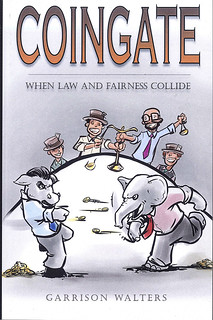 Garrison Walters agrees that Tom Noe committed crimes.
Garrison Walters agrees that Tom Noe committed crimes.
But in his new self-published book, Coingate: When Law and Fairness Collide, the former interim chancellor of the Ohio Board of Regents suggests Noe should never have faced theft charges or been given an 18-year sentence that still has him behind bars.
He argues that errors on the part of the Lucas County prosecutor and judge, overzealous reporting by The Blade, a missing-in-action Ohio Supreme Court, and a tense political climate converged to make Noe “a political prisoner.”
“It’s entirely clear that a ‘nonpolitical Noe,’ someone of no prominence and of no interest to the local media and therefore to politicians, would have been treated very differently in the justice system,” Mr. Walters wrote.
There’s plenty of blame to go around, according to the author, who worked with the former Toledo-area coin dealer and Lucas County Republican Party chairman at the board of regents.
“The reader should walk away with an understanding that the justice system has an enormous amount of discretion built into the early stages and can be seriously warped by political considerations, even if unconsciously,” Mr. Walters said in an interview. “I do believe that they all acted honorably, but they should never have been put in the situation they were in.”
On Nov. 13, 2006, Noe was convicted of 29 charges, 25 of which were felonies, including a racketeering charge carrying a mandatory 10-year sentence. He was convicted on four misdemeanors related to the theft from a $50 million investment for the state’s insurance fund for injured workers made in rare-coin funds he managed.
Noe was convicted of taking money from the fund for his personal use, leaving behind records that sometimes masked the moves as transactions of fund assets.
Prior to starting his state sentence, he served two years in federal prison for using local conduits to launder illegal campaign contributions to the 2004 re-election campaign of President George W. Bush.
The 264-page book reads as part opinion piece and part academic thesis, looking at a justice system gone wrong with Noe as its case study. But Mr. Walters argues in his book that, while certainly guilty of tampering with records and possibly forgery and tax fraud, Noe could not be guilty of theft. The Bureau of Workers’ Compensation had purchased shares in what were essentially hedge funds and did not directly own the coins in those funds, he said.
Noe’s contract allowed his private coin-dealing business to do trades and sell coins with the investment funds and to take loans and advances against profits. The problem, he suggests, came when the state prematurely shut down the funds, exposing Noe IOUs where assets should have been. Mr. Walters said he has no reason to believe Noe lacked the financial wherewithal to make good on those debts.
The book also contends the judge and prosecutor left the jury with the impression that the investments lost money when they made a profit of about $6 million. In hindsight, he agrees the BWC could make the argument it was entitled to that profit plus the value of the IOUs Noe left behind, but he said that wasn’t the argument the prosecution made.
The book contends Noe was caught between a Democratic Party eager to score political points and a scared Republican Party eager to distance itself from him.
“This was a situation in which unconscious bias combined with political expediency to create a situation that simply shouldn’t have occurred,” Mr. Walters said. “I don’t know that, if it were a nonpolitical Noe, there would have been a search warrant and a raid [of Noe’s business office].”
Noe’s convictions and sentence have been upheld at every state and federal appeals level. He has served about half of his 18-year sentence and was recently transferred from the Hocking Correctional Institution in southern Ohio to the Marion Correctional Institution. Both are medium-security facilities.
To read the complete article, see:
BOOKS Author argues Tom Noe ‘political prisoner’ in Coingate
(http://www.toledoblade.com/Books/2017/12/24/Author-argues-Tom-Noe-Political-prisoner-in-Coingate.html)
To read earlier E-Sylum articles, see:
NOE CHARGED WITH 53 NEW COUNTS IN OHIO COIN SCANDAL (http://coinbooks.org/esylum_v09n08a09.html)
MORE PRESS ON OHIO COIN FUND (http://www.coinbooks.org/esylum_v08n21a07.html)
STILL MORE ON OHIO'S "COINGATE" (http://www.coinbooks.org/esylum_v08n22a11.html)
DUPONT COINS INVOLVED IN OHIO SCANDAL? (http://www.coinbooks.org/esylum_v08n23a03.html)
SPECTRUM NUMISMATICS WINS SECRET OHIO CLOSED-BID COIN AUCTION (http://cbt.coinbooks.org/esylum_v09n14a13.html)
NOE BEHIND NEW GOLD COINS; PUSHED FOR PALLADIUM (http://www.coinbooks.org/esylum_v09n15a13.html)
TOM NOE'S HARD TIME (http://www.coinbooks.org/esylum_v10n18a36.html)
COIN DEALER TOM NOE'S CONVICTION UPHELD (http://www.coinbooks.org/esylum_v13n01a21.html)
BOOK REVIEW: TRENCH ART
 Trench Art by Judy Waugh (aka Trench Art Judy) (2015) is a great book. It is as interesting as it is beautiful. I am a trench art fan and collector so that is hardly an unbiased
opinion. This is also a very unusual book in several ways. Obviously, it is unusual to have a 350 page, large-format full-color book on trench art, but the uniqueness goes far beyond that.
Trench Art by Judy Waugh (aka Trench Art Judy) (2015) is a great book. It is as interesting as it is beautiful. I am a trench art fan and collector so that is hardly an unbiased
opinion. This is also a very unusual book in several ways. Obviously, it is unusual to have a 350 page, large-format full-color book on trench art, but the uniqueness goes far beyond that.
This is the only trench art book in which the author does not feel compelled to tell readers what trench art is. In addition to being a trench art book, this is a coin book. Again, the author understates this aspect. It is unlike almost all numismatic books, but it is a coin book nonetheless!
Finally, it is a book about World War I trench art to the exclusion of conflicts before and after although included in the text is discussion of a great item that was created during the Boer War then added to during the Great War. I am less happy with this approach, but I like the comfort and ease with which Waugh engages the discussion as though only World War I could meet her collecting needs. I must say that it is a common assumption that trench art of the Great War is the ultimate if not only trench art which, of course, it is not.
The book subtitle gives you a clue to the unusual approach taken by the author: Trench Art--the stories behind the talismans. Waugh built a collection of World War I trench art with each piece having the name and service number and often religion of the soldier who made or, at least, owned it. Overwhelmingly, the religion listed is Church of England (CE).
Most if not all of these coins with personal data were created and carried or worn for identification purposes. Official government identification tags well known as dog tags were created by the armies involved in the early 1900s. It is my opinion that the coin ID items were created out of tradition or distrust of the official items. In addition, I believe that in some cases the coin tags were made using coins when the official blanks were not available. Coin ID tags are the most common type of World War I coin trench art. While such items were also made and carried in World War II, they were much less common.
 Waugh limits her collection to items that the soldier or sailor in question carried and in most cases likely had some special meaning. Specifically, this excluded trench art items that were
made as gifts. She has a group of twelve amazing trench art musical instruments (see banjo on book cover). I have never seen any and she has a virtual band. Small pocket knives, letter openers,
lockets and more meet her definition.
Waugh limits her collection to items that the soldier or sailor in question carried and in most cases likely had some special meaning. Specifically, this excluded trench art items that were
made as gifts. She has a group of twelve amazing trench art musical instruments (see banjo on book cover). I have never seen any and she has a virtual band. Small pocket knives, letter openers,
lockets and more meet her definition.
Step two was to research the person. Her pieces are spectacular, her stories delightful. She is as good a researcher as she is a collector! She found at least some information on most of the soldiers. In a few cases she photographs! I really appreciate the photographs because I have been doing some research on World War II for which I desperately need some photographs of a specific period soldier and cannot find any.
My personal favorite Great War trench art coin is what I call the Baghdad Schilling. Without using that term (I made it up), the book has more than eight pages on the subject. The Baghdad Schilling is a local coin engraved with a distinctive local scene and of course for this book the identification information of the person who carried it.
The Baghdad Schilling is the most common coin trench art design. To have even two trench art coins with the same design is unusual so to say that this is the most common is not denigrating the coin, but there are far more than two. I know of about eight pieces. While they have the same or very similar designs, they were hand engraved, so each coin is different and of course the names and service numbers are different on each coin. The service numbers can be recorded and tracked like the serial numbers on banknotes! This is a wonderful possibility and I have started a list.
Just when you think that you are really on to something, you find a book to crush your theory. On page 326 a really beautiful coin is illustrated with a design very similar to the one that I described above, but more dissimilar than any other two Baghdad Schillings. When I first saw this beautiful coin, I was in love but crushed. I thought that it ruined my ideas about the Baghdad Schilling because instead of Baghdad, Kazimain is boldly engraved on this coin! After reading the book and doing some other checking, I found that Kazimain is a suburb of Baghdad so I am now happy to include this coin on my list of Baghdad Schillings.
Waugh introduces a theory that I had never before heard. She believes that many of the pieces that required specialized skill and tools were crafted by unit armorers. While I had not heard this idea, it seems similar to what we know about World War II Pacific trench art. There many of the more elaborate pieces were crafted by CBs (construction battalion personnel).
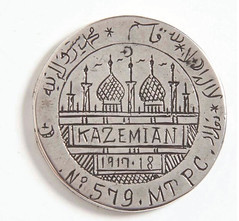 Each of the stories in the book is great. E Hogben (service number 22900) is one of Waugh’s subjects. He had a beautiful mandolin with coin identification tag. It is a wonderful piece.
Waugh found that Hogben was born three days before Christmas 1896 and killed in action at the Battle of the Somme. This is a sad but typical story, but there is more, much more. E. Hogben was a
relative of Judy Waugh! This piece was not handed down for generations then given to the keen collector. No, It survived the decades and likely passed through many hands and at least a few
collections until it was purchased by Waugh as if by fate.
Each of the stories in the book is great. E Hogben (service number 22900) is one of Waugh’s subjects. He had a beautiful mandolin with coin identification tag. It is a wonderful piece.
Waugh found that Hogben was born three days before Christmas 1896 and killed in action at the Battle of the Somme. This is a sad but typical story, but there is more, much more. E. Hogben was a
relative of Judy Waugh! This piece was not handed down for generations then given to the keen collector. No, It survived the decades and likely passed through many hands and at least a few
collections until it was purchased by Waugh as if by fate.
The book includes a nice foreword by Brendan Nelson, Director of the Australian War Memorial where he lauds Waugh’s work and recognizes the significance of trench art in scholarly research. It is not often that we can find such words about numismatics much less numismatic trench art.
The book is available in two formats: printed and digital. The printed version is large--350+ heavy pages with many professional color images. The typography and layout are excellent. Research notes and clues in the end matter should be helpful for anyone who wishes to pursue research along this line. The book is comprehensively indexed with a robust reference list and bibliography. See below for notes on availability.
The digital version is available at Amazon for under $10. That was the first version that I obtained within a few minutes of learning of its existence. I do not have a lot of experience with e books, and expected many problems with downloading and reading. No worries, it worked great. Even today, months later, I went to my Amazon account and was able to read the book there (for the second time). I can rather highly recommend this approach if you like eBooks or do not want to pay for a printed version.
This is a review. I have (appropriately) raved about this book. I am obliged to find some fault. My biggest complaint is that the book came out in Australia in 2015 and I did not find out about it until 2017. True, it was still new to me, but if I had found it earlier I could have consulted it more by now. If I had been producing the book, I would have been slightly less opulent. I would not have had as many full-page images of single coins for example. Some more pages could have been saved in footnotes and reference lists. These are just my opinions. Other people will disagree and reducing printed pages does not necessarily reduce bound pages.
What is it worth? Those are the most common four words and most common question in collecting. Coins, stamps, banknotes, and, yes, trench art. Old timers say that they do not like that. They say that it is the art, the history, even the chase that are important.
There is no correct perspective. Both ideas are important, very important. While it does vary somewhat by where you are in your collecting career. Still, determining and reporting values is a difficult task. This is especially true for such specialized--and special-- items.
Trench Art as published in 2015 did not address values in a comprehensive way. Addressing this shortcoming, Waugh has prepared a values supplement which is being included in each copy henceforth sold here in the United States.
 I ordered a printed version and waited (not very patiently), but it arrived in due course, so I read it again--this time with highlighter, sticky notes, and pen. Next, I ordered a carton (8
copies) and took my copy as a sample to the World’s Fair of Money (aka American Numismatic Association convention) in Denver. At the convention I rather easily sold the eight copies that were on the
way and which arrived while I was at the convention. From that experience, I have ordered another box of eight which have now arrived.
I ordered a printed version and waited (not very patiently), but it arrived in due course, so I read it again--this time with highlighter, sticky notes, and pen. Next, I ordered a carton (8
copies) and took my copy as a sample to the World’s Fair of Money (aka American Numismatic Association convention) in Denver. At the convention I rather easily sold the eight copies that were on the
way and which arrived while I was at the convention. From that experience, I have ordered another box of eight which have now arrived.
Finally, these eight are being offered first to Love Letter readers. if you would like a copy of Trench Art--the stories behind the talismans by Judy Waugh, the price is $75 delivered. If you do not like the book, you may return it (in resalable condition) for a cheerful refund. Please confirm your order including your mailing address in the first email at fredschwan@yahoo.com.
For more information on the Love Token Society, see:
http://lovetokensociety.com/
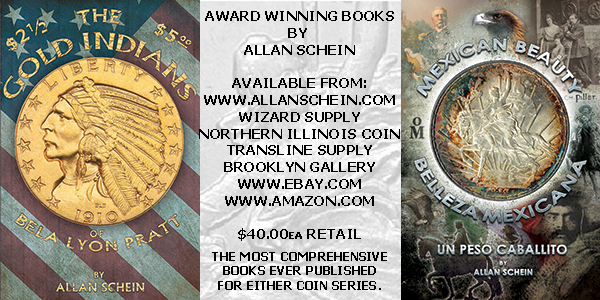
COINS & CHRISTMAS PUDDING ON THE PORTAL
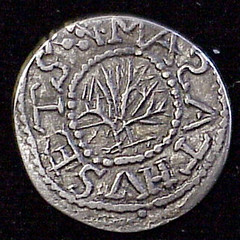 Christmas pudding is a traditional English desert somewhat akin to American fruitcake. An old tradition suggests hiding a silver threepence in the concoction, with the promise of good
fortune for the finder. No doubt more than a few coins have been accidentally ingested. Some related discussion is found via the Newman Portal. During the conversion to decimal currency in 1966, as
reported in the Calcoin News, an Australian woman asked “When the 3-pence pieces go, what are we going to put in the Christmas pudding?”
Christmas pudding is a traditional English desert somewhat akin to American fruitcake. An old tradition suggests hiding a silver threepence in the concoction, with the promise of good
fortune for the finder. No doubt more than a few coins have been accidentally ingested. Some related discussion is found via the Newman Portal. During the conversion to decimal currency in 1966, as
reported in the Calcoin News, an Australian woman asked “When the 3-pence pieces go, what are we going to put in the Christmas pudding?”
A 1987 issue of the NI Bulletin noted the Bank of England was still receiving requests for silver threepence during the holiday season. The 2004 British Numismatic Journal notes this demand as far back as the 18th century. Modern sensibility has largely done away with the practice, due to concerns about microwaving a coin-filled cake, choking hazards, and the lack of circulating silver coins. Illustrated is a Massachusetts threepence from the Alan Weinberg collection.
Link to Fall, 1966 Calcoin News:
https://nnp.wustl.edu/library/book/516438?page=3
Link to March, 1987 NI Bulletin:
https://nnp.wustl.edu/library/book/522922?page=9
Link to 2004 British Numismatic Journal:
https://nnp.wustl.edu/library/book/535980?page=91
Link to Alan Weinberg Massaschusetts silver image collection:
https://nnp.wustl.edu/Library/ImageCollection/510308
NEWMAN PORTAL SEARCH: ISAAC EXCELL
A Newman Portal user this week searched for “Isaac Excell.” Excell was a Chicago collector who consigned to two Ben Green sales (1903, 1905) and one sale of B. Max Mehl (1927). Both of the Green sales include runs of hard times tokens consigned by Excell and cataloged by Low numbers. The August 2012 Stack’s Bowers sale catalog of the Battle Born collection places Excell in the pedigree chain of the finest known 1872-CC quarter (MS66, the next finest being MS62), privately sold to John H. Clapp in August 1905.

This covers his numismatic activities but tells us little about Excell himself. We can surmise he was a longtime collector with widely spaced auction consignments. An 1875 Chicago city directory places him as a “commercial merchant” with the firm of Butts & Excell at 184 S. Water Street, while a Centralia, IL newspaper of 1876 narrows it down to the fruit business. The 1920 census lists him as living with his daughter and son-in-law and notes that his parents were from the UK. A genealogy search finally indicates a death date of 1925, and Mehl’s Coin Circular, March 1927, includes a testimonial from the administrator of the Excell estate (son-in-law John Wallace).
The existence of the finest known 1872-CC quarter in his collection is the unanswered question – how could such a coin, the finest known by four grading points, come into the collection of a little-known Chicago collector?
Link to Ben Green sales:
https://nnp.wustl.edu/library/auctioncompanydetail/510851
Link to B. Max Mehl sales:
https://nnp.wustl.edu/library/auctioncompanydetail/5
Link to B. Max Mehl’s Coin Circular:
https://nnp.wustl.edu/library/publisherdetail/511632
Link to Stack’s Bowers catalogs:
https://nnp.wustl.edu/library/auctioncompanydetail/3
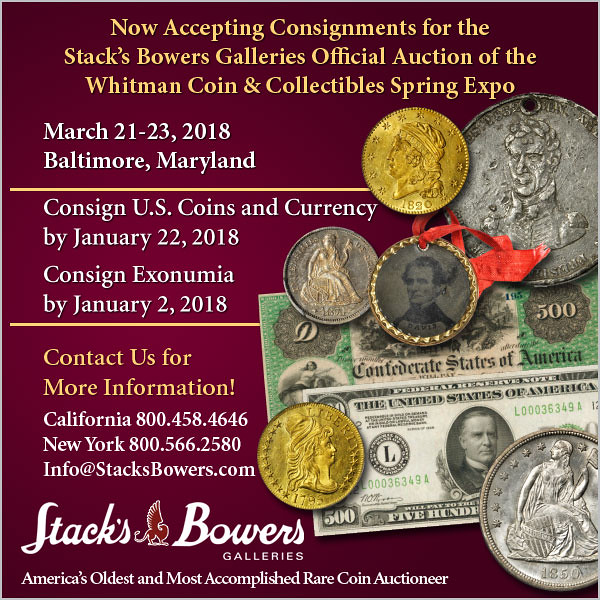
SANTA AND COLONIAL COINS ON THE NEWMAN PORTAL
The inaugural issue of Kelly’s Coins and Chatter came just three months after the beginning of his correspondence with Eric P. Newman which, unsurprisingly, was inspired by a request to inspect some English halfpence that were to be offered in an upcoming Kelly auction. Kelly’s house organ made its debut in June 1948. “Meet My Baby,” Kelly’s first headline announced, promising a bi-monthly publication that would “bring you news and information on Numismatics, along with coins sensibly priced and honestly graded.” It grew along with his business relationship with Newman, and just over a year after its introduction, Newman and Kelly closed their first trade: a swap of four common date double eagles for a 1786 Immunis Columbia copper with New Jersey reverse, Maris 3-C. Initially acquired for the equivalent of $140, it brought 1000 times as much — $141,000 — when sold in Newman V in November 2014.
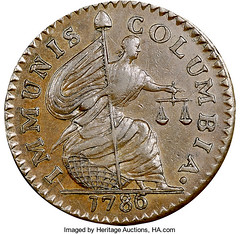
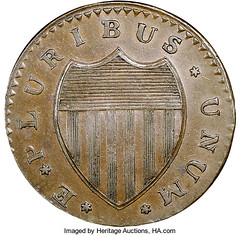
In retrospect, maybe there is a Santa Claus in numismatics, and maybe Jim Kelly was it. Newman’s letters to him show regret that Kelly was practically dropping down people’s chimneys and giving colonial coins away. In a July 1949 letter to Kelly, Newman noted “it is certainly a shame that there are not enough people collecting Colonials to appreciate this lovely material which you are sacrificing. Of course, in due time, they will be craving for these, but in the present they would rather pay the same money for some idiotic mint mark.”
It is only appropriate that the most Kris Kringle-centric publication in the history of numismatics came the year that the relationship between Kelly and Newman first kindled. Printed in red on green paper, with a bold illustration of Santa at center, the December 1948 issue of Kelly’s Coins and Chatter proclaimed wishes of “Merry Christmas to one and all: Here’s hoping Santa fills your stocking with health, happiness, and the many other things needed to make life more pleasant.”
To add to Kelly's best holiday wishes, here's hoping your prized purchase for 2018 is worth 1000 times more in 65 years, and that Santa doesn't fill your stocking with some idiotic mint mark.

To read the complete article, see:
The Portal Opens #4: The Coin Dealer St. Nick (https://nnp.wustl.edu/blog-post/515408)
Kelly's Coins and Chatter, June 1948:
https://nnp.wustl.edu/library/book/516681
1786 Immunis Columbia copper with New Jersey reverse, Maris 3-C:
https://coins.ha.com/itm/colonials/1786-copper-new-jersey-immunis-columbia-ms62-brown-ngc-crosby-vii-17-maris-3-c-breen-1129-w-5670-high-r6/a/1215-3023.s?ic4=ListView-ShortDescription-071515
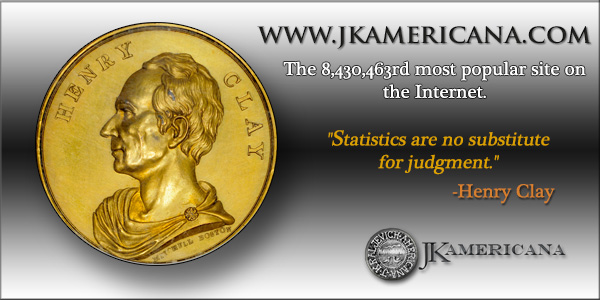
CHRISTMAS CLUB TOKENS
Torkington's Christmas Club Token
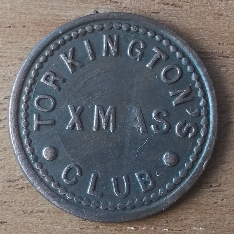

This is a small token made of copper and has TORKINGTON’S XMAS CLUB on one side and on the other side 1d.
There is a place in Cheshire called Torkington but I think it probably is the name of a company rather than a place. It is probably for a factory where employees saved up money each week. Few people had bank accounts in the early part of last century and many clubs, work places and pubs had savings schemes like these. Unfortunately, they were not always safe as the money was sometimes stolen.
I remember in the 1960s there was a savings scheme at the village grocers and the butchers as well. Customers would pay a small amount every week and save up for the big day.
U.S. Christmas Club Tokens
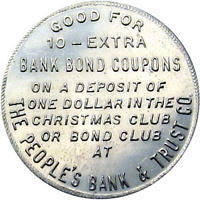
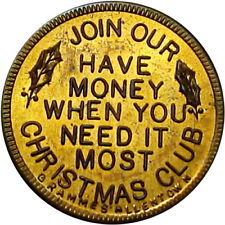
To read the Wikipedia article, see:
Christmas club (https://en.wikipedia.org/wiki/Christmas_club)
U.K. Christmas Club Tokens
David Powell writes:
There is an article on the use of tokens by Christmas Clubs, whereby members saved up for their purchases over the course of the previous year, in my Leaden Token Telegraph newsletter no.115 {pages 3-4}, The tokens were either used as receipts for the money or as pub tokens {drink entitlement vouchers} at the club's meetings.
The concept of saving up for a rainy day, or for a specific event, is not new. The idea of chucking a sum each week or month into the Post Office, bank or building society, in order to lessen the pain of a possible financial outlay when the time comes, goes back further than one might imagine. The organisation which we might trust with our money, or the amount put away, or the means by which we do it; yes, they change, but the concept, no. Some people might even have a special account, distinct from the one which they use for their everyday affairs, for the purpose; imposing a certain discipline on themselves, whereby some money is ringfenced and not allowed to disappear into the general pot. Here we look at some of the ways in which it was done in the past.

Some of you will have worked in offices where one of your colleagues collected small payments each week and there was a big payout in December, ready for the Christmas purchases. Perhaps some of you still do. Others will recall local shops doing the same; the grocer or the butcher, maybe. In those days, even for the older of our current readers, it will have been a paper record that was kept.
In the early 20th cent, and perhaps the late 19th, it was sometimes tokens which were used. In the heyday of brass tokens, benefit societies of various types seized upon the token as a way of receipting payments made towards sickness or burial insurance. These societies were often very locally operated, dealing with extremely modest sums. So, when Christmas started to be more generally celebrated in a manner which involved expenditure on items which could not merely be put aside during the year, local shopkeepers jumped on the bandwagon and started operating along similar lines. Many of them had long been deploying metal bonus checks as a way of tempting people with special deals, so the use of tokens was not wholly foreign.

Figs.1-7 show a number of typical examples. The first four state “Xmas Club “ or “Christmas Club” specifically. Fig.5-6 say “Grocery Club” and “Annual Grocery Club”, respectively, but despite the slight anonymity of purpose one feels that Christmas is more than hinted at. All these first six relate to grocers and state a value on the reverse, usually 3d, which seems to have been the popular weekly contribution; because of the sameness of design I have not illustrated every example. Fig.1, which alone manages to state all it wants to on one side, merely repeats it on side two. Fig.7’s issuer is a tailor rather than a grocer and the initials “CC” are again enigmatic, but as we are told that they are not those of the issuer’s name, “Christmas Club” seems the obvious interpretation.
To read the complete article, see:
Leaden Tokens Telegraph december 2016 : Christmas Clubs …..
(http://www.mernick.org.uk/leadtokens/newsletters/LTT1612_115.pdf)
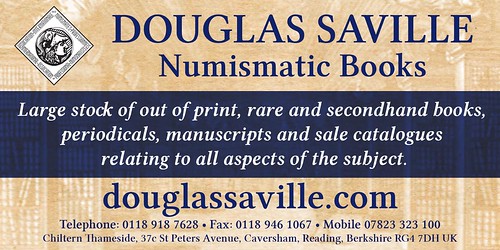
NOTES FROM E-SYLUM READERS: DECEMBER 24, 2017
More Christmas Medals
David Powell writes:
Here is a picture of a calendar medal with Christmas-related reverse.
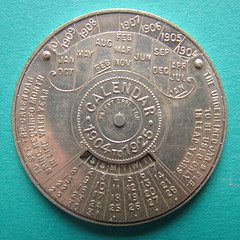
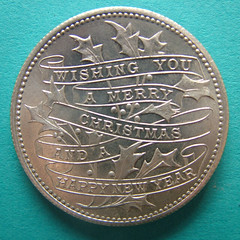
John Sallay writes:
Your holiday-themed medal roundup is really terrific. Thanks very much for organizing us to share a few interesting pieces from our collections. Here’s one more – an unsigned 38mm copper medal by William H. Key from the 1880’s, showing a Holy Nativity scene on one side and group of cherubs (the “Heavenly Host”) on the other.
The reason I don’t say obverse and reverse is that this particular piece involves two dies that were both used as obverses on several different Sunday School award medals in the late-19th century. At the same time, it’s hard to call it a mule because – like Lovett and other American medalists of that period – Key engraved a bunch of dies for his stock medals and then mixed and matched them quite liberally as a matter or course in his medal business, selling whatever the market would bear.
Merry Christmas!


To read the earlier E-Sylum article, see: CHRISTMAS MEDALETS (http://www.coinbooks.org/v20/esylum_v20n52a23.html)
On Jack Black's Coin Collection
Regarding actor Jack Black, David Pickup writes:
One year I spent over £50.00 with the family going to Gulliver’s Travels at the cinema so I think he owes me! His interest in coins makes us even!
And what was the source for that 1913-dated Abraham Lincoln piece? Clearly it was Photoshopped, but I doubt it was totally fabricated. What numismatic item's image did they start with? -Editor
To read the earlier E-Sylum article, see:
ACTOR JACK BLACK'S COIN COLLECTION (http://www.coinbooks.org/v20/club_nbs_esylum_v20n52.html#article19)
Theodore Roosevelt Quotation
 Regarding the Theodore Roosevelt quotation "Aggressive fighting for the right is the noblest sport the world affords," Ted Banning writes:
Regarding the Theodore Roosevelt quotation "Aggressive fighting for the right is the noblest sport the world affords," Ted Banning writes:
Although I can't find the original source of the quotation on the Roosevelt plaque either, it is widely ascribed to Roosevelt himself. In fact, it is one of a number of Roosevelt quotations
inscribed on the inside the Roosevelt Memorial rotunda at the American Museum of Natural History. See:
https://www.amnh.org/exhibitions/theodore-roosevelt-memorial/theodore-roosevelt-quotes .
To read the earlier E-Sylum article, see:
VOCABULARY TERM: QUOTATIONS ON MEDALS (http://www.coinbooks.org/v20/esylum_v20n52a15.html)
Insect Chopmark on U.S. $5 Bill
To read earlier E-Sylum articles, see:
CHOPMARKS ON MODERN U.S. PAPER MONEY (http://www.coinbooks.org/esylum_v17n07a21.html)
MORE CHOPMARKS ON MODERN U.S. PAPER MONEY (http://www.coinbooks.org/esylum_v17n08a08.html)
Periodical Sought: Whitman Coin Supply Merchandiser
Author Dave Lange writes:
The coverage given to 1960s publication The Coin Dealer a few weeks ago reminds me of another periodical for dealers that I've been seeking. During that same decade Whitman put out a publication for its supply dealers that was known under several titles, and I'm trying to obtain or simply locate as many issues as possible. The title used the longest was Whitman Coin Supply Merchandiser, but it also was called at various times Coin Supply Merchandiser or Stamp and Coin Supply Merchandiser. I'm hoping readers may have this publication for either sale or loan. My next book will be on Whitman coin folders and albums, so this could provide some useful dates and facts.
To read the earlier E-Sylum article, see:
THE COIN DEALER (http://www.coinbooks.org/v20/esylum_v20n49a14.html)
Ferry Boat Ticket Information Sought

An E-Sylum reader writes:
The last time I saw Rich Hartzog (it was in Baltimore) I asked about this piece, which he said he had never seen previously and promised to see if he could get any info on it. It appears to be a ferry boat ticket of the early 1800's (supposedly from New York City, although for sure printed in NYC). "Mobilitate viget" is from Virgil, and means "it grows by moving").
Previous to my asking Rich about this I did extensive research on early New York Transit tokens, chits and the like, asked many other sources, including the New-York Historical Society, Heritage and B. Cudahy, author of the definitive work on Ferry Boat stuff from NYC.
Anyway, I came up with almost nothing, and was wondering if any of our readers may have some insight into this thick uniface cardboard piece that measures approx 55 x 50 mm.
Ginger Rapsus on Chocolate Coins
Regarding chocolate coins, author Ginger Rapsus writes:
I used to buy them by the pound & use them as giveaways when I had a book signing, or went to a convention & gave goody bags. Chocolate is always welcome! Happy holidays!
To read the earlier E-Sylum article, see:
NOTES FROM E-SYLUM READERS: DECEMBER 17, 2017 : On Chocolate Coins (http://www.coinbooks.org/v20/esylum_v20n52a11.html)
Quick Quiz: Stunt Pilot Coin Dealer

Pete Smith writes:
Can anyone identify the mystery coin dealer sitting on the wing of a moving aircraft? Hint: He was a coin dealer after retiring as a stunt pilot.

JEFF ROCK REMEMBERS RICH HARTZOG
 I was deeply saddened to read of the passing of Rich Hartzog in last week's issue of The E-Sylum. I bought several things from his World Exonumia sales and, of course, many of
the books that he published and when our paths crossed at shows it was always an enjoyable time at his table going through some of the MANY boxes he carted around -- no matter what you collected he
probably had some.
I was deeply saddened to read of the passing of Rich Hartzog in last week's issue of The E-Sylum. I bought several things from his World Exonumia sales and, of course, many of
the books that he published and when our paths crossed at shows it was always an enjoyable time at his table going through some of the MANY boxes he carted around -- no matter what you collected he
probably had some.
But Rich really stands out to me for a service he performed. About 40 years ago I learned that my great-grandfather had issued a couple of trade tokens for the general store he ran in a small town in Illinois (he was also the postmaster for the town which sounds very grand but really meant the mail train tossed the one sack of mail out with whatever other things were delivered to his store and people from the town would come in and pick up their mail along with their supplies). I had advertised for this token for years, and had offered to pay several hundred dollars for one when "Good For" tokens of this era were usually selling for $10-20. But I never got a single answer to the ads I placed, and no dealers ever had one for sale.
Fast forward a couple of decades, and Rich was selling the Ore Vacketta collection of Illinois trade tokens -- Vacketta literally wrote the book on these tokens, and he was a distributor of groceries so he actually knew the people in the state and they knew him and what he collected, so they were happy to give him some of their tokens for his collection. Unfortunately I hadn't heard about these sales until they were nearly all completed and I wrote to Rich seeing if he had sold the tokens from the tiny town of Grape Creek (so tiny that it no longer exists, having been absorbed into another nearby town). He went back through the catalogues and didn't see any sales, and went through all the remaining tokens from the Vacketta estate -- but no luck. Perhaps, we thought, Vacketta never owned them (though he and my great-grandfather were friendly enough).
Then, out of the blue, I got an excited call from Rich. The estate found a small box of tokens and sent them to him and in this group of 50-odd additional tokens were not one but two of my great-grandfather's tokens, one of each denomination he issued, and the pieces illustrated in Vacketta's book. Rich negotiated a private sale for those two with the estate at a price that was likely higher than what they would have brought at auction, but less than I would have been willing to pay for them. The tokens arrived, and one of them immediately went into my collection. The other one though had a very special fate.
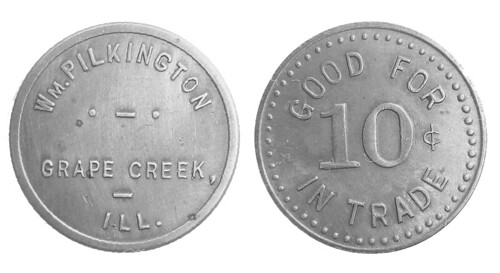
My grandmother, the daughter of the William Pilkington who issued these tokens, was still alive and remembered those tokens from when she was a kid. Her dad had bought her a tiny toy cash register and she would play storekeeper in the shop itself -- ringing up purchases and the like. In the till of that register she had dozens or hundreds of these tokens, and she would sometimes be the one who gave them out to customers. While still a teenager her world was shattered when her father was killed in a freak train accident. She fled Grape Creek, taking nothing with her but a suitcase of clothes, and never saw any of those tokens again. We never found out what happened to them - though it's likely that they were redeemed and then melted down in one of the many scrap metal drives for World War II. I didn't tell her that I had -- finally! -- found the tokens, and for Christmas of that year she received a really nice hand-carved wooden box that had a few trinkets in it. At the bottom, wrapped up separately, was her father's token, which she called the best Christmas gift she ever received.
Several years later as her own health was failing she packed an "emergency bag" that had things she would need if and when she went to the hospital. In it was some money, her checkbook, some records and documents that were important -- and this token, one of the only links she had to happier times as a child. When she passed away the token went to her daughter, my mother, who will make sure that it finds its way to the next generation.
When Rich found the tokens for me the deal was that I would write an article on the owner of the store and the area, which was something that was often missing in the literature -- that personal context. But sadly this didn't happen. My grandmother was supposed to write down her memories and I would shape them into an account, but she constantly put it off -- thinking of those days would inevitably get her thinking about the loss of her father, and 70 years later that was still too emotionally raw. But, as we were cleaning out my grandmother's house after she passed away I found several notebooks that included pages of memories about the store and her time there -- perhaps enough to belatedly write this article that was promised to Rich. If so (and I will make it a priority to get through in 2018!) then it will definitely be dedicated to Rich; it's just a shame that it would be done only after the two people most interested had both passed away.
To read the earlier E-Sylum article, see:
RICHARD HARTZOG (1947-2017) (http://www.coinbooks.org/v20/esylum_v20n52a06.html)

VOCABULARY TERM: JACK DIE
Jack Die. A die with no design; a blank die; it is used to strike uniface medals. The jack die is usually placed in the upper (punch) position in a press, while the obverse die is in the lower (pile) position. If a jack die has been machined to fit within a collar in a coining press it can only be used to strike pieces in that diameter. If the jack die is an OPEN FACE die, conceivably, it could be used to strike any diameter piece smaller than its diameter. Some jack dies have a rim or border, however if the die contains any lettering or symbols it is not a jack die.
In cataloging coins and medals a side struck with a jack die containing no detail is described as plain or blank. Often a manufacturer will use a die with no detail other than the firm’s logo. This should not be considered a blank reverse struck by a jack die but should, indeed, be cataloged in full, identifying all lettering and symbols (if any) of the maker.
However, in the rare instance of a reverse with a single letter or symbol – with no other relation to the obverse or the maker – it can be considered the designation for the jack die. An example is the reverse of the Lafayette medal by James Bale (Fuld LA.1824.1); contains a tiny letter P in the signature position (lower right).
A die with a nondescript design used like a jack die is called a DIAPER die.
Reference: CLASS 04.4
NC8 {1957} Fuld, illustrated p 1040.
Looking for the meaning of a numismatic word, or the description of a term? Try the Newman Numismatic Portal's Numismatic Dictionary at: https://nnp.wustl.edu/library/dictionary
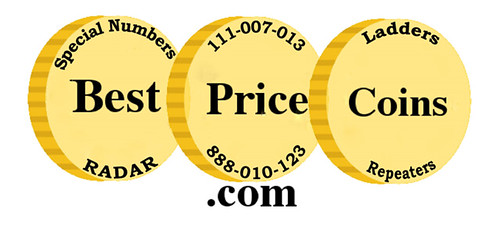
ISAAC EXCELL (1846-1925)
Isaac Excell (1846-1925), was born the eldest of eight children, in August 1846, at New York City, son of English immigrants, Robert Excell (1824-1899), a carpenter by trade, and Emily Kirkby (1827-1872).
His family to moved to Chicago, Cook County, Illinois, about 1857.
In 1863, his father became the owner of a saloon, and Isaac worked for him there as a barkeeper.
In 1872, at Shopiere, Wisconsin, he married Geneva A. Palmiter (1846-1913), a native of New York.
He was a commission produce merchant who operated variously with different partners. Butts & Excell operated on South Water Street from 1875-1876. In 1876 he was reported to have sold bad eggs to Isaac Turrowsky. Excell claimed they switched the eggs insisting he sold them fresh eggs. A fist fight broke out and Excell was arrested and fined. In 1877, his new partner was James L. Ford. He and Ford were brought up on charges to defraud a Mr. Todd. The judgment was set against Excell and Ford to pay $50.94.
In the 1880 U. S. Census he is listed working as a bookkeeper married to Geneva and their four children ; Fred Oliver (1873-1956), Jennie, Irene Claudia (1877-1949), and Robert.
Isaac Excell is ANA Member No. 95.
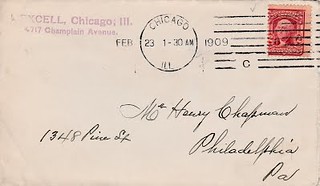 Beginning in 1895 he became a client of the Chapman Brothers buying coins. There are several pieces of correspondence with the Chapman Brothers in the Lupia Numismatic Library, Special
Collection.
Beginning in 1895 he became a client of the Chapman Brothers buying coins. There are several pieces of correspondence with the Chapman Brothers in the Lupia Numismatic Library, Special
Collection.
In April 1902 he advertised to trade a nearly complete set of US silver coins all mint marks and denominations , a fine lot of cents and half cents and over 50 varieties of Hard Times tokens and Hawaiian cents for 1801 and 1802 half dollar; 1824 Quarter-dollar; Dimes of 1797, 1798, 1801-1804, Hard Times Tokens, etc.
On July 18, 1903, he consigned coins to be sold at auction by Ben G. Green's Sale No. 6.
In August 1905, he privately sold John H. Clapp the Eliasberg 1872-CC Arrows, VG8, Liberty Seated Dime, May 4-5, 1999, Stack's Sale of Herman Halpern, lot 2128.
In 1920 he was a widower, retiree, living with his daughter Irene Claudia Wallace and son-in-law, John Foster Wallace, a real estate broker at 5112 Dorchester Avenue, Chicago, Illinois.
He died on May 3, 1925, and is buried with his wife at Milton Junction, Rock County, Wisconsin.
Excell's son-in-law John Foster Wallace was executor of his estate and finding some Mehl invoices wrote to Mehl, visited him and then shipped his late father-in-laws coin collection intact to him by American Express.
His coin collection was sold posthumously by B. Max Mehl Sale No. 75, April 12, 1927.
To read the complete article, see:
EXCELL, ISAAC (https://sites.google.com/a/numismaticmall.com/www/numismaticmall-com/excell-isaac)
The entire inventory of the Lupia Numismatic Library is for sale. Individual items will be available before the remaining archives are broken up into parcels sold at philatelic auctions in the U. S. and Hong Kong. Check NumismaticMall.com frequently as dozens of new items with estimates will be posted daily until everything is sold.
All inquiries will be given prompt and courteous attention. Write to: john@numismaticmall.com .

ARTICLE PROFILES THE ALASKA MINT
Tell us about your company.
Our family business is one of a kind. We offer a large variety of products including; Alaskan themed medallions, locally made native crafts, natural gold jewelry, estate jewelry, and many more. The cool part about our store is that we manufacture a lot of our products in-house in our production room. We buy raw gold nuggets and gold-bearing quartz from miners, with these natural elements, we create one-of-a-kind jewelry. While the pieces are rare, they are surprisingly affordable. We make great gifts and souvenirs not only for tourists but locals as well. Coming to the Alaska Mint is an experience in itself, getting to see all the Alaskan history on the walls, ceilings and just about everywhere you look.
What was the inspiration for opening your business?
I grew up in the jewelry business so I got introduced to it at a young age and something I noticed was that every jewelry store was exactly the same. So, I sought out to make one that was different and would stand out. I always was fascinated with coins, so one day I went to the U.S. Mint in Denver and one of the things that they let you do is mint your own coin. After minting that first coin I knew what I wanted to do, I wanted to start a mint. So I gathered all the parts to make a coin press and in 1990 I minted my very first coin, and the rest is history.
Why did you choose Downtown?
I worked at the mall and I would ride my bike downtown and I noticed it was busy with visitors everywhere. So I got a sidewalk vendor permit, there I sold 1 style of silver coin, gold nugget earrings, and rabbit skins. The coin was very popular with all the visitors, so I decided that downtown was the best place to start my store. I started out in the old City Hall in the summer of 1990, then I moved into E. street terrace, now known as bear square. The store was upstairs and the minting was done downstairs. At the end of 1999, we moved into our current location.
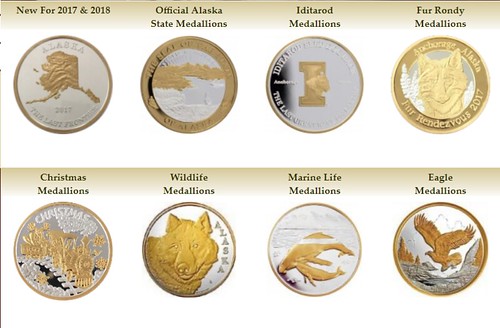
To read the complete article, see:
ADP PROFILE: The Alaska Mint
(http://www.anchoragepress.com/news/adp-profile-the-alaska-mint/article_3fee9336-e6b5-11e7-a10a-37fb59ea2d4f.html)
To visit the Alaska Mint web site, see:
https://alaskamint.com
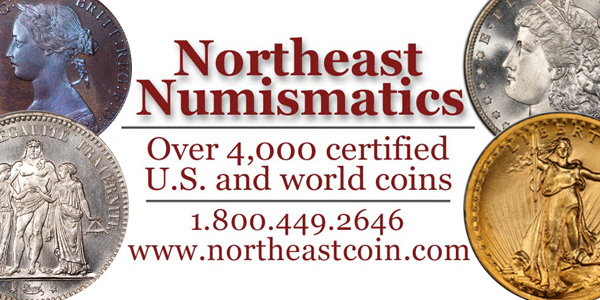
BANKNOTE ENGRAVER ROBERT SAVAGE INFO SOUGHT
Ondrej Tucek writes:
I am trying to obtain information and photographs regarding the engraver Robert Savage. I am currently organizing an exhibition that will celebrate next year the artistic as well as artisan legacy of famous Czech artist Alphonse Mucha. Mr Savage engraved two important Czechoslovakian banknotes - one was issued in 1919, the other in 1920. With both banknotes he followed the design of Mr Mucha. Also, both banknotes were - according to Czech sources - printed by the American Bank Note Company.
The exhibition titled Mucha: Art and Artisanship will be held in the Municipal Museum in the town of Carlsbad/Karlovy Vary from June 20th to August 14th 2018 - coinciding with the 53rd year of the Karlovy Vary International Film Festival. Any help readers can provide will be greatly appreciated. i can be reached via email at ondrejtucek@email.cz .
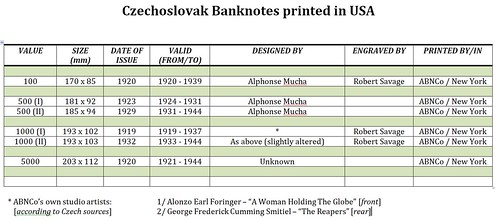
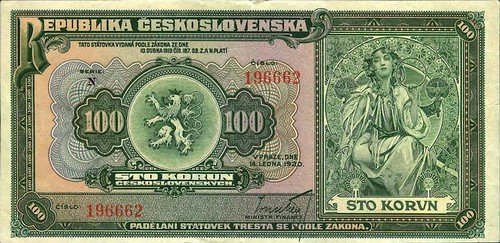




NUMISMATIC NUGGETS: DECEMBER 24, 2017
1795 Draped Bust Dollar
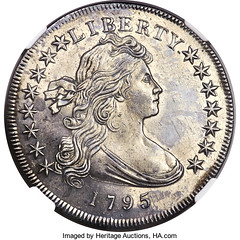

The 1795 B-14, BB-51 dollar with an off-center Draped Bust represents the first appearance of the new obverse design. The Small Eagle reverse also made its first appearance here. The circumstances surrounding the coin's issuance are subject to a certain amount of speculation. The designer and engraver remain unidentified, the exact timing of the Mint's transition from the Flowing Hair design to the Draped Bust type is uncertain, and the actual mintage of the new design is a further unknown variable relating to the production of 1795 Draped Bust dollars.
To read the complete lot description, see:
1795 $1 Draped Bust, Off-Center, B-14, BB-51, R.2,
(https://coins.ha.com/itm/early-dollars/silver-and-related-dollars/1795-1-draped-bust-off-center-b-14-bb-51-r2-sp62-ngc/a/1271-4893.s)
1814 Czar's Visit to Paris Medal
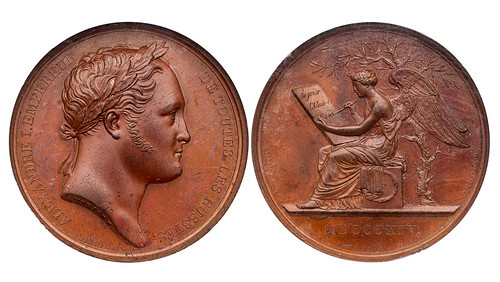
RUSSIA. ALEXANDER I, 1801-1825
Bronze “Paris Visit” Medal, 1814, 40 mm. Engraved by Andrieu and Denon.
Obv. Laureate head of Alexander I right.
Rev. Victory seated left below tree, inscribing tablet “Sejour Alex I Paris”.
Julius 3015. Diakov 378.1.
NGC graded MEDAL MS 63 BN, exceptional specimen of the finest artistic style and great, rich coppery color.
To read the complete lot description, see:
ALEXANDER I RUSSIAN BRONZE MEDAL
COMMEMORATING THE CZAR’S VISIT TO PARIS – MS 63 BN NGC GRADED RUSSIAN MEDAL (Inv. 10654)
(https://vilmarnumismatics.com/product/alexander-i-russian-bronze-medal-commemorating-the-czars-visit-to-paris-ms-63-bn-ngc-graded-russian-medal-inv-10654/)
1838-O Half Dollar
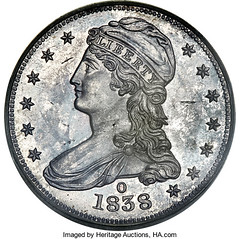

The 1838-O Reeded Edge half dollar is one of the rarest and most enigmatic issues in the U.S. federal series. Despite an auction history that dates back to 1867 and intense study by prominent numismatists ever since, the coin's origin remains shrouded in mystery. PCGS CoinFacts estimates a surviving population of 10 examples, from an original mintage of 20 coins. PCGS and NGC have combined to certify nine coins between them, including a few crossovers and resubmissions (11/17). We have been able to locate only nine specimens still extant, with one coin included in the National Numismatic Collection at the Smithsonian Institution.
To read the complete lot description, see:
1838-O 50C GR-1, R.7, Branch Mint PR63 PCGS. CAC....
(https://coins.ha.com/itm/reeded-edge-half-dollars/half-dollars/1838-o-50c-gr-1-r7-branch-mint-pr63-pcgs-cac/a/1271-4861.s)
1850s Australian Steam Navigation Co. Tokens
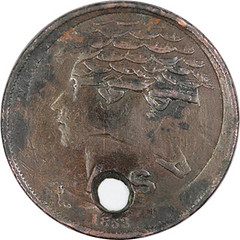
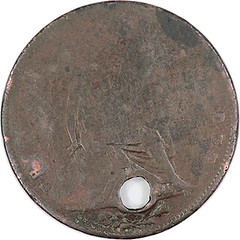
Notes: Undated but struck circa 1850s. The Penny is Rarity 9 and the Halfpenny is Rarity 10 and probably unique. The Penny token is over-struck on an Victoria Penny of 1853 and although pierced is good Fine for issue and is the clearest known example of this type. The Half Penny token over-struck on a 1826 George IV Half Penny is Fine/Good with graffiti on the reverse.
This token is pictured in the 'Renniks Australian and New Zealand Token Values (2012)' where it is mis-identified as a Penny token over-struck on a Victoria 1853 Penny. Dr Arthur Andrews in his book 'Australasian Tokens and Coins (1921)' records the existence of a Half Penny token over-struck on a George 111 Half Penny and mentions over-strikes known on other coins, although none appear to have have been sighted since.
The tokens are accompanied by a notice of a 'Special General Meeting of the Proprietors' of the Australasian Steam Navigation Company " called on the 29th November, 1886 "for the purpose of taking into consideration a proposal for the purchase of the Company's Fleet. " In 1887 the ASN and Co. merged its fleet with the Queensland Steam Shipping Company to form the Australasian United Steam Navigation Company.
To read the complete lot description, see:
Lot 102: Australian Steam Navigation Co. Penny & Halfpenny Tokens (2 coins)
(https://www.invaluable.com/auction-lot/-1-c-C87400897C)
1904 Beirut Charity Token
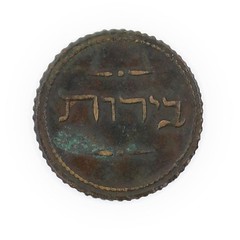
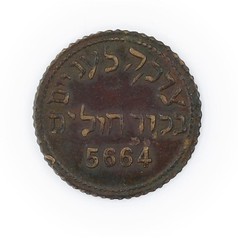
Description: Charity token, brass. Beirut, Lebanon, 5664 [1904]. Obverse: the Hebrew legend "Charity for the poor, visitation of the sick, 5664". Reverse: the legend "Beirut". The token's edge is serrated. Diameter: 22 mm. See: "Jewish Tradition in Art, the Feuchtwenger Collection of Judaica" by Dr. Yesha'ayahu Shachar (Jerusalem: Israel Museum, 1971), item 164b.
To read the complete lot description, see:
Lot 469: Charity Token - Beirut, 1904 (https://www.invaluable.com/auction-lot/-1-c-98E41A0808)

JANUARY 2018 STACK’S BOWERS SALE HIGHLIGHTS
Stack’s Bowers Galleries is pleased to announce details of their January 2018 auction held in conjunction with the prestigious New York International Numismatic Convention (NYINC). The sale features world coins, world paper money and ancient coins and will be held January 11-13 2018 at the Grand Hyatt Hotel in Midtown Manhattan.
The Ancient and World coin sale will take place over two days, with Session C commencing on Friday evening, January 12, at 6:30 PM ET. Session E will be held Saturday, January 13 at 6:30 PM ET. Session B, featuring World paper money, is scheduled to begin Friday. January 12 at 1:30 PM ET. In addition, Stack’s Bowers Galleries will present The Eldorado Collection of Colombian Coins and Paper Money across three days, beginning with Session A: The Eldorado Collection of Colombian Paper Money held on Thursday, January 11 at 12:00 PM ET. Session D: The Eldorado Collection of Colombian and Ecuadorian Coins Part 1 will be held Friday, January 12 at 6:30 PM ET. Session F: The Eldorado Collection of Colombian and Ecuadorian Coins Part 2 will be held Saturday, January 13 at 6:30 PM ET.
World coins ranging from Afghanistan to Guatemala comprise Session C. Lot 20065 offers an impressive highlight of the session, the “King of Canadian Coins,” a 1921 50 Cents. This coin is exceedingly rare in any grade, with this example graded an incredible PCGS Specimen-62. Also to be presented in this session is a portion of the Alex Siegel Collection, featuring high grade date runs of coins from Argentina, Chile, Costa Rica and Guatemala (more highlights from this collection – including coins of Mexico – can be found in Session E). Standout pieces from this collection in this session include a Mint State Chile 1867 Peso and a high grade Costa Rica 1831 8 Reales.
The offering of 125 French coins in this session is simply stunning and includes nearly a dozen major highlights. Lot 20135, a Royal d’Or of Philip IV, begins this tremendous run of medieval French gold coinage. Just three lots later, a magnificent Pavillon d’Or of Philip VI de Valois in NGC MS-65 is featured, and is sure to elicit excitement. From the same king is a lovely type depicting St. Michael the Archangel – Lot 20144 – a rare Ange d’Or. The next French highlight is a lovely Mint State Hardi d’Or of Charles issued for Aquitaine. Lot 20178, a Double Henri d’Or of Henry II, continues this run of rare and desirable French gold. A very rare Double Louis d’Or Aux Insignes is featured as Lot 20207, and is a marvelous piece with traces of the coin it was struck over visible and adding to its appeal. A Demi (1/2) Louis d’Or au Buste Habille is found in Lot 20227 and is an extremely rare type that has not surfaced in a U.S. auction in the last decade.
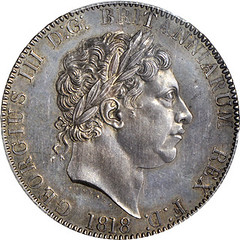
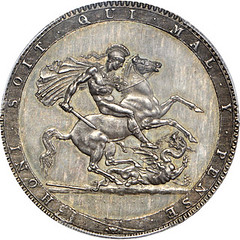
Among coins of Germany, a massive Quedlinburg 8 Ducat is offered as Lot 20277, a hefty, extremely rare and ornately designed piece. The 124 lots of British coinage range from the 9th century through to Queen Elizabeth II, and there is certain to be something for all collectors. The first major highlight is a lovely sovereign issue of Queen Elizabeth I, a highly desired type found as Lot 20299. A visually stunning nine-piece set from Soho Mintmaster James Watt Jr. (sold as three lots, arranged by metal type) is preceded by a richly detailed introduction. Immediately following the three Proof sets is a 1818 pattern crown by Pistrucci, which also offers ample historical information. This marvelous coin, Lot 20350, is destined for a collection of significant caliber. A gorgeous “Old Head” Queen Victoria 10-piece Proof set with gorgeous toning is featured as Lot 20384. Guatemala rounds out the session, with a strong run of the aforementioned Alex Siegel Collection pieces.
The bidding resumes on Saturday evening at 6:30 PM ET with Session E, which begins with Ancient coins and also covers the remainder of the world coin lots starting with Haiti. The Ancients section opens with a nice run of Syracusan gold minors. Additional highlights include a Cyzicus EL Stater with a lion’s head (Lot 21036) and a Judaean First Jewish War Year 3 Half Shekel. Among Roman coinage, a nice run of Aurei from multiple emperors is culminated by a choice Julian II AV Solidus (Lot 21072).
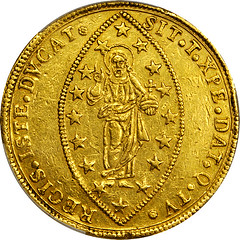
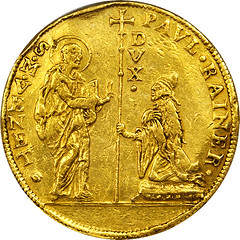

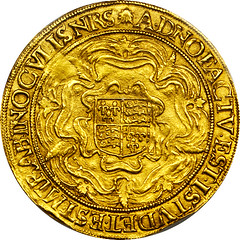
Immediately following the final Ancient coin lot are World coins, beginning with Haiti. The session’s highlights are led by the monumental Venetian 40 Zecchini of Doge Paolo Ranieri (Lot 21136). This massive and important piece represented significant wealth and prestige to the original owner, and is worthy of inclusion in the finest collection. A fantastic Japanese 1874 50 Sen (Lot 21140) represents an extremely rare key date that was missing from the esteemed Dr. Norman Jacobs and Cornelius Vermuele collections. Mexico offers 126 lots, with some high powered and significant pieces. The first is Lot 21153, an iconic “MX” 8 Reales with single letter assayer’s mark. Immediately following that piece is a Mint State 1733 8 Reales as Lot 21154. Lot 21161 offers an imaginary bust of Ferdinand VI, a very rare and visually distinct piece. This is followed by over two dozen gold 8 Escudos, republic coinage, and a run of two dozen gold medals, most of which are from the Mexico Numismatic Society.
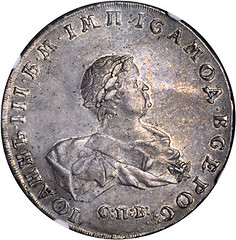
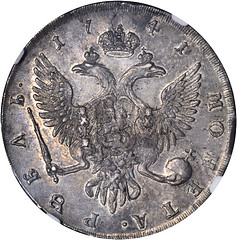
Peru offers Lot 21280, a lovely Mint State 1712 8 Escudos and Lot 21286, a gorgeous Sun Face 8 Escudos. Highlights among Russian coins include a Tynf and a Ruble of Peter I (the Great) as lots 21319 and 21321 respectively. The tragedy of the young emperor Ivan VI makes for compelling reading, with this story told in lots 21327 and 21328. The first is an exceptionally rare Ruble issue of the already scarce Ivan, featuring an obverse legend that extends further underneath the bust. The second is one of the first Rubles struck by Elizabeth, who usurped the throne from young Ivan and hurriedly began striking her own coinage. Other exciting pieces of Russian numismatics follow, and include Lot 21351, a rare beautifully toned Proof-only 1898 50 Kopek. Following Russia is a nice run of Swedish plate money (with more examples in the online session). The “Holy Grail of Odd and Curious” a Yap Island Stone money (approximately 62 pounds and 20 x 17 inches) is sure to draw considerable attention.
There will also be several Internet Only Auction Sessions, each packed full of desirable numismatic items. Session E will offer 282 lots of Ancient coins, as well as 1,000 World coin lots (from Afghanistan to Great Britain) and will begin promptly at 9:00 AM PT on Monday, January 15, concurrent with the World paper money Internet Only Session G. The second half of the World coins – Session J – featuring over 1,1000 lots of coins from Greece to Yugoslavia, will be held on Tuesday, January 16 and begin at 9:00 AM PT. A substantial special collection, the James Heegeman Collection of New Zealand Tradesmen Tokens anchors Session J and certainly warrants in-depth study.
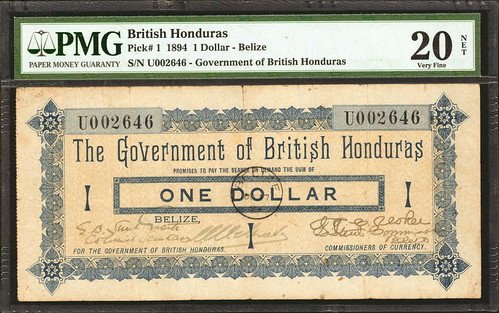
A few of the most desirable World bank notes can be found within this catalog, with some being the finest, and in a few cases the only notes known for their types. Some of the scarce pieces hail from British Honduras. Stack’s Bowers Galleries is offering an Issued 1894 1 Dollar Type 1 note (Lot 30070) that comes directly from the family of Albert E. Morlan, American Consul in Belize City in the 1890s. Also offered is a 5 Dollar Specimen (Lot 30071) from the same series, which should equally excite collectors. Among Bank of Canada notes, Stack’s Bowers Galleries will feature a pair of gem notes (Lots 30093 and 30096), with Serial Number 9, along with many rare charter and private bank notes that include a Union Bank of Canada 50 Dollar note (Lot 30115). There is also a very strong assortment of Australian of notes led by a 6 Pence note and a 2 Shillings note from the Camp Hay Internment Camp Seven (Lot 30022 and 30023). Other highlights include a very scarce Puerto Rico 5 Pesos from 1896 in VF 25 condition (Lot 30390), the finest certified example of the type according to the PMG census.
For more information, see:
http://www.stacksbowers.com/
THE BOOK BAZARRE
JANUARY 2018 HERITAGE PAPER MONEY SALE HIGHLIGHTS
More than 1,600 lots of World Paper Money from around the globe are expected to be among the most coveted lots presented by Heritage Auctions, the world’s largest numismatics auction house, at the FUN World Currency Auction Jan. 4-8 in Tampa, Fla.
“This event has been extremely successful for us in recent years, and we anticipate similarly strong results this year,” Heritage Auctions Currency Consignment Director Dustin Johnston said. “We have compiled an extensive collection of currency from around the world, enough to appeal to collectors of many different kinds of currency.”
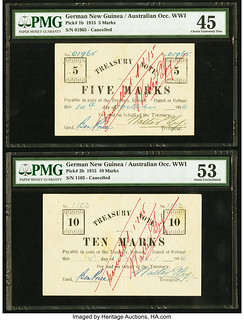 A rare set of four German New Guinea Australian Occupation WWI notes (est. $200,000-240,000) very well could end up claiming top-lot honors at the event. The set includes four of the five
known denominations issued, all in incredible condition compared to other known survivors. German New Guinea notes issued under Australian occupation in World War I are so scarce that it has been
more than a decade since two of these denominations have been offered at auction.
A rare set of four German New Guinea Australian Occupation WWI notes (est. $200,000-240,000) very well could end up claiming top-lot honors at the event. The set includes four of the five
known denominations issued, all in incredible condition compared to other known survivors. German New Guinea notes issued under Australian occupation in World War I are so scarce that it has been
more than a decade since two of these denominations have been offered at auction.
A South Vietnam National Bank of Viet Nam 1000 Dong ND (1955-56) Pick 4As Specimen (est. $40,000-50,000) is easily one of South Vietnam’s most coveted designs. The French polychrome inks remain bright in this design depicting Vietnamese scenes; the Old Man and Temple design is one of the most popular engraving on all of World Paper money. All features are enhanced by the stainless French banknote paper.

A Spain Banco de Espana 500 Pesetas 1.10.1886 Pick 37 (est. $20,000-30,000) is extremely difficult to find in any grade range, much less an example at PMG Extremely Fine 40 Net. One of the rarest pieces of paper money in all of Spanish Numismatics, this early Spanish piece has been repaired, but that is overshadowed by the sheer rarity of the note. This 500 Pesetas is the only example graded by PMG.
This Pakistan State Bank of Pakistan Haj Pilgrim Issue 10 Rupees ND (1950) Pick R2 (est. $15,000-20,000) may well be the finest Haj Pilgrimage 10 Rupees note from the first Pakistani issue, and was printed for use in Saudi Arabia by Pakistan’s attending Haj. This note is rarely seen, especially in such pristine condition, which underscores the likelihood that it will be extremely popular among serious collectors.
The auction also will include a collection of rare Hawaiian notes, both in issued and proof form. Among the group’s top lots:

A Hawaii Kingdom of Hawaii $100 ND (1879) Pick 4b Remainder (est. $25,000-35,000) from the Art Davidson Collection was acquired by the consignor from a Newman auction featuring a set of proofs, $10 through $100. The final member of this Hawaiian Islands remainder set is exceedingly rare in any form. The face design is memorable and combines stellar elements from the ABN repertoire, including a globe at the center that shows the Americas. At the left is a steamer headed west and a train headed east, with palm trees in the background. Also included are images of a cow and a galloping horse. One of the auction’s most attractive notes, with blue tints not often seen on earlier American Obsolete or Federal type notes. The note was printed in 1879 – 80 years before Hawaii became a state. Davidson’s collection includes many Federal issues in the United States Currency Auction at this event, all incredible $100 notes spanning the history of U.S. currency.
A Hawaii Kingdom of Hawaii $100 ND (1879) Pick 4b (est. $15,000-25,000) is the highest denomination of the first series. This is a particularly rare example – even more so than proofs or specimens – because fewer of these high denominations were released. Because of large American business interest at the time, corporations preferred to have large sums of money in U.S. dollars. Notes did not fare well in the unforgiving climate, making notes like this one with the bright blue inks intact very rare.
Another Hawaii Department of Finance $5 1895 (1899) Pick 6p Face Proof (est. $10,000-15,000) features the classic golden design from the Series B Gold Coin issue. There was another subsequent gold coin series, but all features in that series were executed in blue. This note features outstanding intaglio embossing and underprints, as well as serial numbers made up only of zeroes and four POCs over the signature area.
Other top lots include, but are not limited to:
Danish West Indies Dansk-Vestindiske National Bank 20 Francs 1905 Pick 19a: est. 30,000-35,000
Government of Ceylon 50 Rupees 50 Rupees 1.11.1909 Pick UNL: est. $12,500-17,500
Government of Fiji £20 ND (1937-51) Pick 43s Specimen: est. $10,000-15,000
Reserve Bank of India 1000 Rupees ND (1954-57) Pick 46s Jhunjhunwalla 6.9.1 Specimen: est. $10,000-15,000
Reserve Bank of New Zealand £50 1.8.1934 Pick 157: est. $10,000-15,000
Government of India 1000 Rupees ND (1928) Pick 12e Jhunjhunwalla 11.2A: est. $10,000-12,000
Central Bank of the Bahamas $50 1974 Pick 40a: est. $8,000-10,000
For more information, see:
http://www.ha.com/
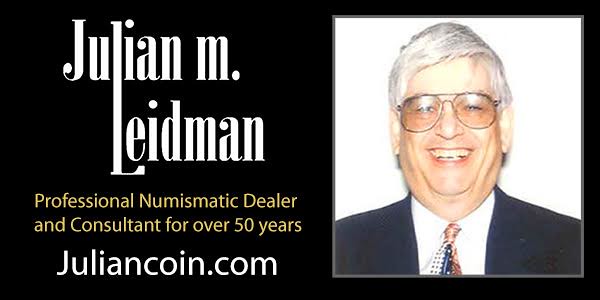
MORE ON THE 1894 BRITISH HONDURAS NOTES

Until very recently, the 1894 British Honduras first emission One Dollar plate note in the Pick catalog was considered unique by the banknote-collecting community, as the only known issued example from 1894 of any denomination, although in AD condition (“Absolutely Destroyed!”)
This note was a prized piece, despite its execrable condition, in the collection of Amon Carter, Jr., the Texas magnate. After his death in 1982, his holdings were disbursed, and the note was sold by Spink in October, 1997.
I had always wondered about the horizontal shadow seen in the Pick catalog across the full width of the British Honduras P-1 plate note. In Europe years ago, I finally had my first opportunity to hold the note itself in my hands. Then I understood that it was no shadow. It was sticky brown ooze coming through from the old tape on the back. The note had been “circulated-to-pieces,” and the tape was there to hold together its four completely separated segments !
In a seismic and unexpected event, a second example surfaced in 2017. Fortunately, this one is a beauty. It is PMG-graded Very Fine 20 net, and has no major detractions. It will be auctioned in New York on January 12, 2018, as Stack’s Bowers Lot 30070. It has sterling provenance, as the consignor is the great-granddaughter of Albert E. Morlan, the U.S. Consul in 1890s Belize, British Honduras.

An equally remarkable piece immediately follows in Lot 30071. It is the Five Dollar denomination, in specimen form, with full counterfoil. Stack’s Bowers comments that this is the finer of only two 1894 Five Dollar specimens they have verified, grading it a conservative “bright and unmarked Extremely Fine or better.”
Both pieces are characterized and authenticated by the repeated watermark of a crowned C C, indicating “British Crown Colony.” This watermark was used by British Honduras only for the 1894 first issue, and never again.
The significance of these two notes is accentuated by their place of honor on the catalog’s front cover. They are also the only notes in the sale each accorded its own full two-page spread.
The 1894 emission circulated for only a few weeks before being replaced. It’s difficult to overstate the importance of these prohibitively rare landmark notes. They are absent from virtually every collection in the world, even the most preeminent.
To read the complete lot descriptions, see:
BRITISH HONDURAS. Government of British Honduras. 1 Dollar, 1894 Issue. P-1. PMG Very Fine 20 Net. Ink Stamp. Splits, Minor Rust.
(https://auctions.stacksbowers.com/lots/view/3-95OF1)
BRITISH HONDURAS. Government of British Honduras. 5 Dollars, 1894. P-3s. Specimen. Extremely Fine.
(https://auctions.stacksbowers.com/lots/view/3-95Q32)
UNISSUED EDWARD VIII NOTES HIGHLIGHT REGINA SHOW
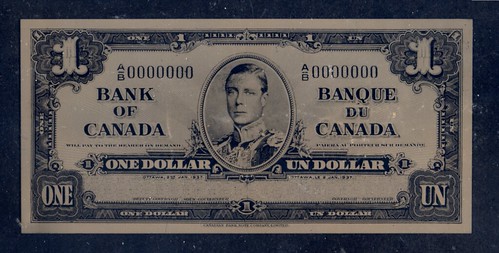
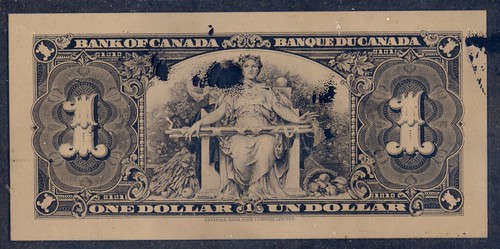
The Regina Coin Club Show in April 2018 features a set of unissued 1937 Bank of Canada bilingual $1 notes that depict King Edward VIII.
When King George V died on January 20, 1936, his eldest son became king. He took the name Edward VIII. For several years, Edward VIII had been involved with an American divorcee named Wallis Simpson and wanted to marry her. Marriage to a divorced woman was not allowed because the King, as head of the Church of England, was sworn to uphold his title as Defender of the Faith.
Edward VIII decided that he would rather give up his kingship than not to marry the love of his life. So on December 10, 1936, Edward VIII signed the Instrument of Abdication. The next day, Edward made a farewell radio broadcast to the nation from Windsor Castle, and left for France by ship, never again setting foot in Britain.
Edward VIII married Wallis Simpson on June 3, 1937 in France. Not one member of the Royal Family attended the wedding, much to the chagrin of the married couple.
But before 42-year-old Edward VIII abdicated, new British and Commonwealth coins, medals and paper money were proposed.
Edward VIII did not like his right profile of his face, preferring his left side. As his father, George V faced left on his coinage, Edward VIII refused the longstanding tradition of having the new monarch face the other direction. But he was king and overruled Royal Mint and other officials.
So images were designed and a small number of British patterns were made prior to his abdication. All are rare. Coins bearing Edward’s name (but not his portrait), were issued for six overseas colonies including British East Africa, British West Africa, Fiji and New Guinea, as well as the Indian states of Jodhpur and Kutch.
On display at the Regina Coin Club show is a set of photographic tintype proofs of the face and back of the proposed Bank of Canada bilingual $1 banknote dated Jan. 3, 1937.
By October 1936, both the Canadian Bank Note Company and the American Bank Note Company had received orders from the Bank of Canada to design new banknotes that would replace those issued in 1935. These proofs were the fruits of their labour.
The face of the note depicts the central vignette of Edward VIII, as Prince of Wales, in the uniform of the Seaforth Highlanders, while the back of the note depicts an allegorical figure of a woman representing agriculture.
These are the only known examples of an Edward VIII portrait on Canadian currency in private hands.
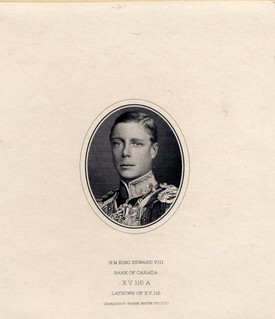 Also on display will be a die proof vignette of H.M. King Edward VIII that was used to make the tintype proofs. The vignette includes the hand signed signature of the engraver, Robert
Savage.
Also on display will be a die proof vignette of H.M. King Edward VIII that was used to make the tintype proofs. The vignette includes the hand signed signature of the engraver, Robert
Savage.
The excellent book, Portraits of a Prince: Coins, Medals and Banknotes of Edward VIII by Joseph S. Giordiano Jr, indicates that the rarity of the tintype proofs is what the writer calls virtually unique, while the vignette is described as excessively rare.
Edward VIII died in 1972. He is buried in the Royal Cemetery at Frogmore at Windsor Great Park. His wife is buried beside him.
The Regina Coin Club thanks an anonymous Canadian collector for lending us these proofs for our coin show. The Regina Coin Club show and sale takes place April 21-22, 2018 at the Turvey Centre near Regina.
For more information on the Regina Coin Club, see:
http://www.reginacoinclub.com/
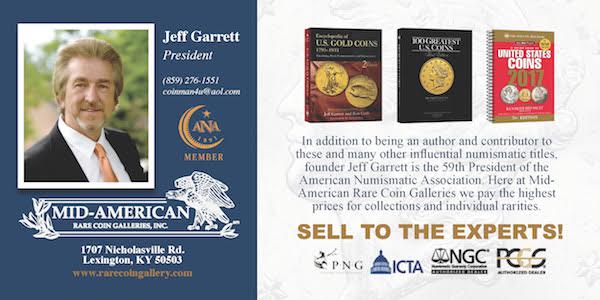
THE MYSTERY OF MAINE’S VIKING PENNY
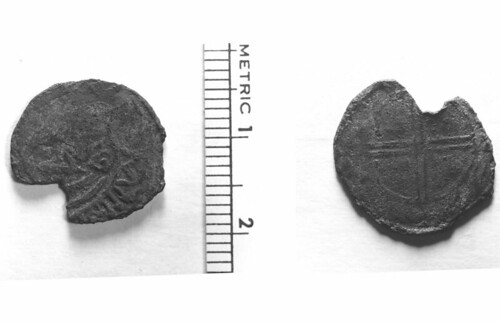 THE STORY THAT GUY MELLGREN told about the curious silver coin began on the shores of Maine, where he met a stranger named Goddard. In the fall of 1956, Mellgren and Ed Runge, a pair of
amateur archaeologists, had come in search of the most basic of coastal dig sites—a shell midden—when they happened onto a more unusual discovery.
THE STORY THAT GUY MELLGREN told about the curious silver coin began on the shores of Maine, where he met a stranger named Goddard. In the fall of 1956, Mellgren and Ed Runge, a pair of
amateur archaeologists, had come in search of the most basic of coastal dig sites—a shell midden—when they happened onto a more unusual discovery.
Goddard had invited them to explore his shoreline property, and there, on a natural terrace about eight feet above the high tide line, they found stone chips, knives, and fire pits, along with an abundance of other unexpected artifacts. Each summer for many years, Mellgren and Runge returned to excavate the “Goddard Site,” with little help from professional archaeologists. In the second summer, they produced the coin.
For two decades, based on an analysis by a friend in a numismatics club, Mellgren described it as a coin minted in 12th-century England, and no one questioned that identification. The discovery should have been noteworthy—there’s no good explanation for how a medieval English coin could have crossed the Atlantic—but Mellgren never sought wider attention for the find. It was a curiosity to show off to friends and his son’s classmates, until, in 1978, a scrappy regional bulletin published a picture of the coin and an article titled, “Were the English the First to Discover America?”
That picture found its way to a well-known London dealer, who recognized at once that the coin could not have come from England. Two weeks after Mellgren died, the coin’s reidentification swept into the news. It was a Norse penny, made between 1065 and 1093—evidence for Viking contact with North America centuries before Columbus.
All of sudden, experts from around the world began taking a careful look at the details of Mellgren’s story. Of many objects purported to prove a Viking presence in North America, only the artifacts painstakingly excavated at L’Anse aux Meadows, in Newfoundland, have stood up to investigation. The rest—the Beardmore relics, the Vinland Map, the notorious Kensington Rune Stone—are all considered hoaxes.
Since 1978, no one has questioned that the Mellgren coin is an authentic Norse penny, made in medieval Scandinavia. But 60 years after Mellgren’s find, archaeologists and numismatic experts are still asking how in the world this small, worn coin got to Maine.
ON FEBRUARY 6, 1979, KOLBJØRN Skaare, a Norwegian numismatist with a tall, wide forehead, walked into the Maine State Museum to see the coin. Just a few years earlier, he had published Coins and Coinage in Viking-Age Norway, a doctoral thesis that grew from the decade-plus he had spent as a keeper at the University of Oslo’s Coin Cabinet. The first specialist to examine the coin in person, he had just a day with it before Bruce J. Bourque, the museum’s lead archaeologist, had to address the national press.
Skaare saw “a dark-grey, fragmentary piece,” he later wrote. It had not been found whole, and the coin had continued to shed tiny bits since it was first weighed. A little less than two-thirds of an inch in diameter, it had a cross on one side, with two horizontal lines, and on the other side “an animal-like figure in a rather barbarous design,” with a curved throat and hair like a horse’s mane. In his opinion, it was an authentic Norwegian penny from the second half of the 11th century.
Medieval Norse coins aren’t an unheard-of rarity. In 1879, farmers in a potato field in Gressli, Norway, had discovered a hoard containing 2,301 coins from the reign of Olaf the Peaceful, the period Mellgren’s penny dated to. Many of those coins were exact duplicates of each other, and the University of Oslo had sold off the extras between the 1880s and the 1920s.
But the Mellgren coin isn’t quite like the ones from the Gressli hoard, which have been described as looking like they’re newly minted. The Maine penny was much more worn, and not an exact duplicate of any coin in the university’s collection. In the 1970s, many experts were inclined to believe the coin was a genuine discovery.

Coins from the Gressli hoard.
In hoaxes and other overinterpreted archaeological finds, usually “the hopes outrun the evidence from the very start,” writes archaeologist Stephen Williams in Fantastic Archaeology. But in this case, Mellgren didn’t try to attract attention to the penny. Whatever hopes he had about the significance of his find, he kept them quiet.
“It’s reasonable to suspect that the Norse penny was a plant,” says Bourque, who only recently stepped down as the Maine State Museum’s chief archaeologist. “The balance of the evidence argues it’s an honest find.”
After Mellgren’s coin was identified as Norse, the Maine State Museum sent a team of professional archaeologists to the Goddard Site to better understand the context the coin had come from. While no other Norse artifact has ever been found there, the site did hold surprises—artifacts attesting to an explosion of trade contact between Native American groups, stretching from the eastern Great Lakes up to Labrador. At the same time the coin shows up, for instance, archery first appears in the region.
“The site has an unspeakably dense concentration of archers,” says Bourque. Excavations have turned up thousands of arrowheads, along with mounds of pottery sherds and stones that come from hundreds of miles away. “It’s off the charts,” he says. “The real mystery is—what the hell is going on at the site at the time?”
To Bourque, the coin is a clue in this other mystery. All sorts of objects that seem out of place in 12th-century Maine show up in this one spot, as if it were site of a pre-Columbian World’s Fair for northeastern coastal America, from Lake Erie to Newfoundland. Unlike the sagas—all story, little evidence—this site is full of interesting evidence in search of a story.
To read the complete article, see:
The Mystery of Maine’s Viking Penny
(https://www.atlasobscura.com/articles/maine-norse-penny-archaeology-vikings-north-america)
To read the earlier E-Sylum articles, see:
QUERY: THE MAINE PENNY (http://www.coinbooks.org/esylum_v12n50a17.html)
RAY WILLIAMS ON THE MAINE PENNY (http://www.coinbooks.org/esylum_v13n41a13.html)
THE MAINE PENNY: A MEDIEVAL COIN FOUND IN NEW ENGLAND SOIL (http://www.coinbooks.org/esylum_v13n40a22.html)

TRUMP UNVEILS CHALLENGE COIN
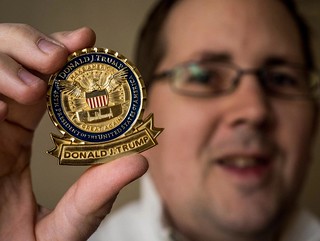 For two decades, the commander in chief has doled out distinguished-looking coins as personal mementos. Now, the presidential “challenge coin” has undergone a Trumpian transformation.
For two decades, the commander in chief has doled out distinguished-looking coins as personal mementos. Now, the presidential “challenge coin” has undergone a Trumpian transformation.
The presidential seal has been replaced by an eagle bearing President Trump’s signature. The eagle’s head faces right, not left, as on the seal. The 13 arrows representing the original states have disappeared. And the national motto, “E pluribus unum” — a Latin phrase that means “Out of many, one” — is gone.
Instead, both sides of the coin feature Trump’s campaign slogan, “Make America Great Again.”
The changes don’t stop there. In addition to his signature, Trump’s name appears three times on the coin, which is thicker than those made for past presidents. And forget the traditional subdued silver and copper: Trump’s coin, a White House aide marveled, is “very gold.”
The aide said the president, whose real estate properties are known for their gilded displays of wealth and status, was personally involved in redesigning the coin. Trump, who also had a hand in creating his famous red campaign hat, “wanted to weigh in on it,” the aide said. “It’s beautifully made.”
“They’re going to be used in ways they haven’t been in the past,” said the second White House aide, adding that they may be distributed at campaign rallies and to donors. Aides were not authorized to comment on the record and spoke on the condition of anonymity.
White House officials declined to say how much the coins cost or who designed them.
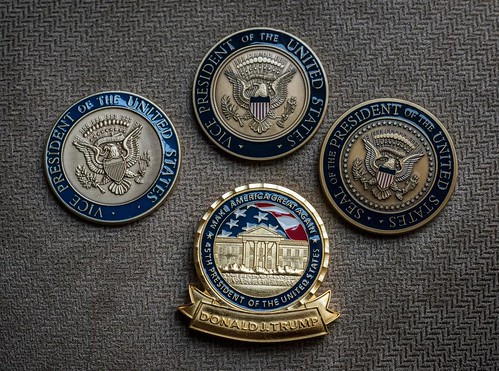
President Trump's challenge coin, bottom, along with those of, from left, Vice President Pence, former vice president Joe Biden and former president Barack Obama
Some ethics experts questioned the unprecedented decision to include a campaign slogan on the coins, which are often distributed to members of the military.
“For the commander in chief to give a political token with a campaign slogan on it to military officers would violate the important principle of separating the military from politics, as well as diminishing the tradition of the coin,” said Trevor Potter, a Republican former chairman of the Federal Election Commission.
Challenge coins got their start as military baubles bearing division insignia and presented by officers to troops for exemplary service. The moniker came from a tradition in which service members challenged one another to produce their coins. Those who did not have one had to buy a round of drinks.
Presidents Bill Clinton, George W. Bush and Barack Obama have pressed the discs, slightly larger than a silver dollar, into the palms of officers and troops. Bush was said to place them on graves at Arlington National Cemetery.
The coins are hotly sought by collectors. Online, the official Obama challenge coin was being sold Friday for as much as $999.
Collectors often display the coins in a glass case or laid flat under a glass coffee table. But Trump’s coin, nearly twice as thick as those of his White House forbears, is designed to literally stand on its own. It features a gold-plated, ribbon-shaped banner bearing his name in capital letters — DONALD J. TRUMP — that doubles as a rocking-horse-style base.
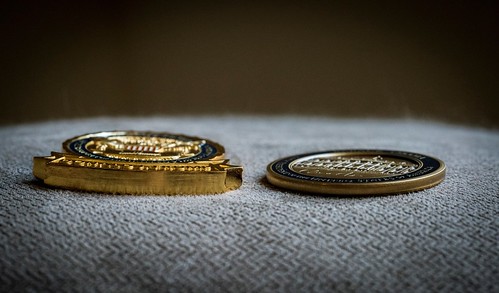
Trump: "Mine's bigger."
President Trump's challenge coin, left, next to that of former president Barack Obama.
“It’s definitely not a standard coin,” said John Wertman, a collector of federal challenge coins who served as special assistant to the director of presidential letters and messages in the Clinton White House. He was among the first to get Trump’s coin, having received one in the mail at his Northern Virginia home after sending a letter of request to the White House.
After entering the White House, Trump asked aides to have the coins he received be displayed in the Oval Office, where a case is positioned behind the Resolute desk. Another case of coins is in the president’s library, aides said. (In Clinton’s official White House portrait, he is portrayed standing in front of his challenge-coin display.)
As in past administrations, Trump’s Cabinet has gotten into the act, including Interior Secretary Ryan Zinke, who has a coin with his name on it.
Spicer had one of his own featuring a lectern on the back. A longtime Navy reservist, he has amassed a collection of about 150 coins, including one presented to him from Bush at the White House when he was promoted to commander.
To read the complete article, see:
It’s ‘very gold’: The
presidential coin undergoes a Trumpian makeover
(https://www.washingtonpost.com/politics/its-very-gold-the-presidential-coin-undergoes-a-trumpian-makeover/2017/12/22/23c8b11e-e5bb-11e7-ab50-621fe0588340_story.html)
THE BOOK BAZARRE
PIGEON'S DICKIN MEDAL FETCHES £8000
 A Second World War medal awarded to a pigeon for her service to the RAF has been sold an impressive £8,680 (inclusive) at auction.
A Second World War medal awarded to a pigeon for her service to the RAF has been sold an impressive £8,680 (inclusive) at auction.
Princess was among 32 pigeons that have received the Dickin Medal, which is the animal equivalent of the Victoria Cross.
Auctioneer Russell Beard previously described the medal as:
“Very rare and a collector’s dream.”
Princess was awarded the medal after returning safely to her loft at RAF Alexandria from a 500 mile mission to deliver vital information.
Today, she is known in the history books as one of the finest performances in the war record of the Pigeon service.
Princess was awarded the medal after returning safely to her loft at RAF Alexandria from a 500 mile mission to deliver vital information. Today, she is known in the history books as one of the finest performances in the war record of the Pigeon service.
To read the complete article, see:
Hero Pigeon's Medal Fetches A Coooo...l £8000 At Auction
(http://www.forces.net/news/hero-pigeons-medal-fetches-cooool-ps8000-auction)
To read the earlier E-Sylum article, see:
CARRIER PIGEON'S DICKIN MEDAL UP FOR SALE (http://www.coinbooks.org/v20/esylum_v20n51a27.html)

2017 ARMENIA HYBRID COTTON-POLYESTER BANKNOTE
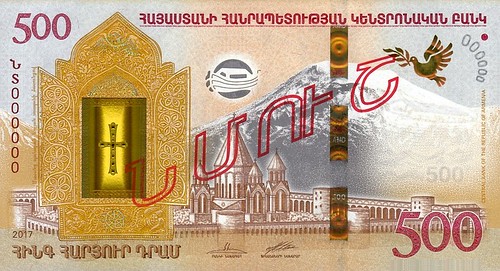
The Central Bank of Armenia have issued (22nd November) a new commemorative bank note which pays homage to the story of Noah’s Ark — a biblical story which has a particular connection to the land of Armenia and its people. In the Book of Genesis, the Mountains of Ararat are the place where Noah’s Ark came to rest after the great flood. Near the top of Mount Ararat — long considered a historical symbol of Armenian identity, explorers claim to have found Noah’s Ark. A team of evangelical Christian explorers claim they’ve found the remains of Noah’s Ark beneath snow and volcanic debris on Mount Ararat, in present-day Turkey.
The 2017-dated bank note with the denomination of 500 drams is printed on an alternative to traditional cotton fibre paper, which combines paper covered with thin polyester layers on both sides and was developed by the German-based company Louisenthal, a subsidiary of the technology company Giesecke & Devrient, who are a recognised and leading international manufacturer of bank note paper, security paper, and security features. The Hybrid bank note substrate is currently promoted as bringing the advantages of paper bank notes and polymer bank notes together in an innovative combination of protective polyester film around a cotton fibre core. Hybrid substrate bank notes are in circulation on four continents (Africa, America, Asia and Europe) which combines security with durability.
The note which is gold, grey, brown, and blue in colour measures 140 x 76 millimetres and incorporates a variety of the latest security features including a multi-tone watermark with an image of Noah’s Ark and the two-tone watermark reflecting the nominal value of the bank note. An optically variable ink security feature on the face of the bank note is in the form of a dove with an olive branch in its mouth, the colour shifting effect variates from gold to green in bright “swimming” 3-D circles. A transparent window is placed almost in the centre above the image of the Monastery of Etchmiadzin, which is a precisely defined stylised image of Noah’s Ark.
Of particular focus is a KINEGRAM security foil application on the face of the bank note containing a 3-D image of the Noah’s Ark fragment with dynamic and colour shifting effects from gold to green, as well as bright patterns in the upper and lower parts of the Noah’s Ark reliquary.
The face of the note includes images of a reliquary (a container for relics) with a fragment of Noah’s Ark and the Monastery of Etchmiadzin. In the background is the familiar view of Mount Ararat.

The back shows a depiction of Noah and his family with animals and birds said to have boarded the famed Ark two-by-two around them. In the background is an image of Mount Ararat.
To read the complete article, see:
Armenia: New technology incorporated into latest bank note
featuring Noah’s Ark theme (http://world.mintnewsblog.com/2017/12/armenia-new-technology-incorporated-into-latest-bank-note-featuring-noahs-ark-theme/)
To read the earlier E-Sylum article, see:
ARMENIA ISSUES COMMEMORATIVE HYBRID BANKNOTE (http://www.coinbooks.org/v20/esylum_v20n49a38.html)
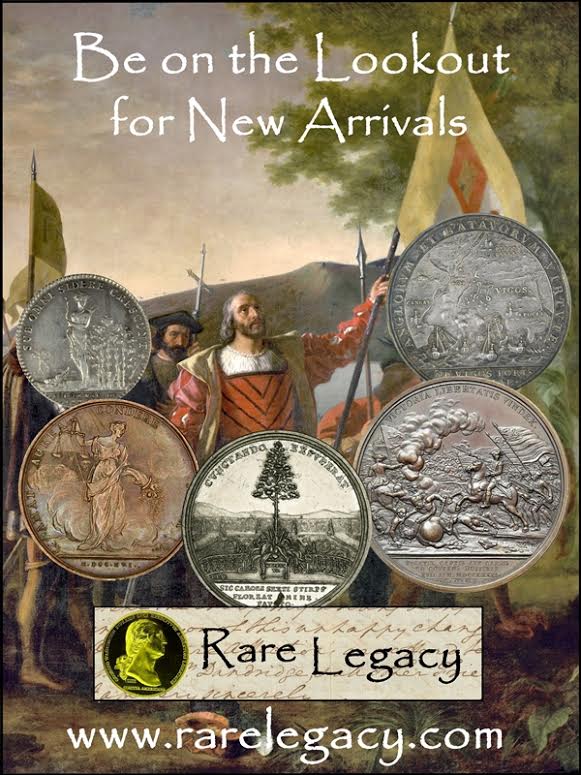
RUSSIAN VIDEO PROMOTES BANKNOTE USE
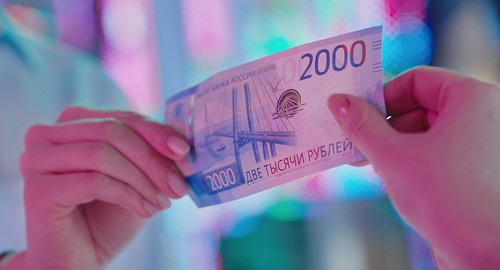
It seems people in Siberia are wary of taking new Russian bank notes with images showing the newly annexed Crimean peninsula and the Russian Far East (RFE). Indeed, a local news crew released a video online showing clerks at a Siberian store refusing to accept the new 2,000 ruble notes. “The designs of the 200 and 2,000 ruble banknotes featuring landmarks in the annexed Crimean peninsula and Russia’s Far East were first unveiled last fall. On Thursday, Russia’s central bank published a slick music video remake of the popular “Vladivostok 2000” song by the Mumiy Troll rock band to publicize the new banknotes,” writes The Moscow Times.
The video includes a ‘dabbing’ babushka and a singing Central Bank chairwoman Elvira Nabiullina.

To read the complete article, see:
Funny Russian Central Bank Video: You’ve Never Seen New Bank Notes
Promoted Like This…Guaranteed (https://tsarizm.com/news/2017/12/23/russian-central-bank-video-youve-never-seen-new-bank-notes-promoted-like-guaranteed/)
To read the earlier E-Sylum articles, see:
RUSSIA TO ISSUE CRIMEA BANKNOTE (http://www.coinbooks.org/esylum_v17n28a24.html)
UKRAINE BANS RUSSIAN CRIMEA BANKNOTE (http://www.coinbooks.org/v20/esylum_v20n43a21.html)
GERMAN BANKER COUNTS 1.2M PFENNIG COINS
Dick Johnson writes:
As a hobby a German truck driver collected German coins, but only two denominations, one and two pfennig. Not for numismatic purposes by vanities, but by quantity. Coins from circulation, as many as he could acquire.
He died early 2017 and his estate found his “collection” of about 1.2 million coins. All previous to the transition to the euro in 2002. He had placed the coins in freezer bags, ending up with 5,500 pounds of coins. Since the coins had iron in their composition, some had rusted together. This prevented their counting by machines.
The coins had to be counted by hand. One bank agreed to tackled the massive task. It took six months. The bank finished the chore this week. Final count 8,000 euros, $9,400.
To read the complete article, see:
Why a German Banker Spent 6 Months Counting Pennies
(http://fortune.com/2017/12/19/why-a-german-banker-spent-6-months-counting-pennies/)
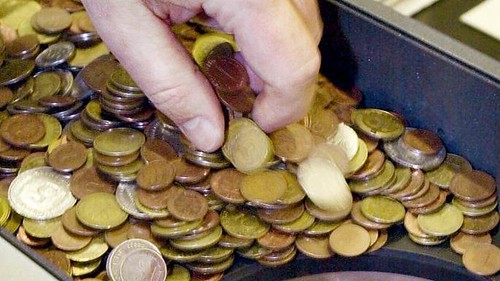
A German bank worker has spent every working day for six months counting 2.5 tonnes of copper coins left by a lorry driver to his relatives.
The family loaded the 1.2 million one and two pfennig coins — obsolete since 2002 when Germany adopted the euro — wrapped in hundreds of freezer bags, into a van and drove to a branch of the Bundesbank, the German central bank, in Oldenburg, northern Germany, after the man died in May.
What followed was a monotonous, challenging summer and autumn for Wolfgang Kemereit, the official given the job of cleaning, sorting and counting the money. Each bag took him about an hour and he performed the task alongside his regular duties.
“I held every coin in my hand,” Mr Kemereit told NDR, the broadcaster. “But I like doing things like that so it wasn’t a problem.” He added that it was not possible to count the money by machine because many of the coins were rusty and stuck together. His tally came to €8,000.
The mark can be exchanged free of charge at any of the Bundesbank’s 35 branches at an exchange rate fixed at 1.96 marks to €1.
Many Germans mourn the demise of the mark, symbol of their postwar economic miracle. They still hold 12.65 billion marks in piggy banks, drawers, under mattresses and down sofas.
To read the complete article, see:
German banker counts 1.2m pfennig coins left in lorry driver’s will
(https://www.thetimes.co.uk/article/german-banker-counts-1-2m-pfennig-coins-left-in-lorry-drivers-will-l8rccjf3s)
CHINESE AUTO DEALER COUNTS FIVE MAO COINS

We've all got our own piggy banks at home and wonder what we'd be able to buy with the amount we've saved.
Well, in China, it turns out you'd be able to buy yourself a new car, as a businessman made his first down payment on a BMW in coins.
According to local reports the unnamed man, who works in wholesale business, bought the car for around 400,000 yuan (£45,000/$60,000) on 18 December.
However, he insisted on paying the first instalment in five mao (5p) coins totalling nearly £8,000 ($106,86). That's one way of putting them to use, I suppose.
"They [the coins] were all five maos that the client had been saving over the years. There were worth about 70,000 yuan (£7,954) in total,' said Mr Gu, sales manager of BMW in Putian, Fujian Province to Pear Video.
Workers at the car retailer were forced to spend hours on the shop floor sitting counting the copper coins.
Apparently, they even travelled to the client's house to pick up around 10 boxes of coins. That's some hardcore dedication to making a sale, you have to say.
Sadly you wouldn't be able to get away with this stunt in many other countries. In the UK you'd be lucky to be able to buy a bus ticket if you weren't holding the right change.
This is because countries have different definitions of what is called 'legal tender' - the currency you can legally use to pay off a debt. In the UK this comes in the form of Royal Mint coins (the ones with the Queen's head on) and bank notes.
In the UK there are restrictions on how lower value coins can be used as legal tender. Copper 1p and 2p coins can only be used to pay for debts up to 20p - enough for a Freddo, but not much else.
5p and 10p non-bronze coins can be used for payment not exceeding £5 - handy if you're short when running for a bus. 20p and 50p coins, though, are valid for payments up to £10.
To read the complete article, see:
Man Saved So Much In A Penny Jar He Bought A BMW
(http://www.ladbible.com/news/interesting-man-saved-so-much-in-a-penny-jar-he-bought-a-bmw-20171221)

NUMISMATIC CRIME INFORMATION CENTER SEEKS DONATIONS
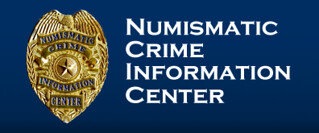 Every day more and more collectors and dealers become victims of numismatic crime. Recently a collector was the victim of a theft that resulted in the loss of a currency collection valued
at over $40,000. After reporting the offense to local law enforcement officials the victim contacted the Numismatic Crime Information Center. NCIC reached out to the agency to offer assistance and
then immediately sent out an alert to the more than 6,000 NCIC network members.
Every day more and more collectors and dealers become victims of numismatic crime. Recently a collector was the victim of a theft that resulted in the loss of a currency collection valued
at over $40,000. After reporting the offense to local law enforcement officials the victim contacted the Numismatic Crime Information Center. NCIC reached out to the agency to offer assistance and
then immediately sent out an alert to the more than 6,000 NCIC network members.
During the next several months NCIC assisted in coordinating the investigative strategies between the victim, law enforcement and several dealers. The investigation resulted in the recovery of ninety percent of the victim's collection.
Numismatic Crimes are complex and challenging to law enforcement and in most cases devastating to victims. However, the educational and investigative resources provided free to law enforcement, dealers and collector's is having an impact in combating numismatic crime.
In 2018 we will be launching a new website, adding additional investigative resources, enlarging our email crime alert network and continuing the presentation of accredited "Numismatic Crime Investigations" training to law enforcement across the country. To accomplish these strategic initiatives we need your financial support. A tax deductible donation can be sent to P.O. Box 14080 Arlington, Texas 76094 or at Numismaticcrimes.org.
As a member of the numismatic community your experience, knowledge and involvement is critical to our continued success. With your help we can make a difference.
Thank You and have a Happy and Safe Holiday Season!!!
Doug Davis
817-723-7231
Doug@numismaticcrimes.org
The Numismatic Crime Information Center is a 501 (c)(3) non-profit corporation. P.O. Box 14080 Arlington, Texas 76094.
For more information, or to donate see:
http://numismaticcrimes.org/?q=node/9
FAKE NEWS: CHUCK E. CHEESE TOKEN ALCHEMY
A New York man has been arrested after he reportedly made over a million dollars selling Chuck E. Cheese tokens as Bitcoins on the streets.
Marlon Jensen, 36, was arrested a Sunday morning when NYPD stormed his home. NYPD received calls from the fraud victims that someone had sold them “Bitcoins”, only to find out there actually was no tangible bitcoin currency available. NYPD found $1.1 Million of cash inside Marlons home. According to police, Marlon had scratched off most of the Chuck E. Cheese engravements on the coins, and would write “B” on each coin with permanent marker.
As many should know already, Bitcoin is a crypto currency and payment system that has recently received unprecedented popularity and value, with each bitcoin currently worth $18,950 USD. Although Bitcoin isn’t actually a tangible form of currency, that hasn’t stopped some people from successfully selling “bitcoins” to people using irrelevant gold coins, in this case Chuck E. Cheese Tokens.
“People are retarded haha”, said NYPD Officer Michael West, “My 8 year old son would know those weren’t bitcoins and lord knows he’s not the brightest”.
Marlon is currently being charged with fraud and can face up to 5 years in federal prison.
To read the complete article, see:
Bitcoin Scam: Man Arrested After Making Over $1 Million Selling Chuck
E. Cheese Tokens As “Bitcoins” (http://lifestories.news/2017/12/18/bitcoin-scam-man-arrested-making-1-million-selling-chuck-e-cheese-tokens-bitcoins/)
A story of a "Bitcoin scam" fired across the web this week telling of a New York City man who made $1 million in cash selling doctored Chuck E. Cheese tokens as Bitcoins, the skyrocketing digital currency.
Share after share on social media showed people praising the story's conman for duping apparent idiots into falling for the faux currency. They, of course, were the ones duped.
The story, "Man arrested after making over $1 million selling Chuck E. Cheese tokens as 'Bitcoins,'" was published on Huzlers.com with no byline.
Scroll to the bottom, past the Facebook comment praising the man's plan as "genius," and you find this disclaimer: "Huzlers.com is the most infamous fauxtire & satire entertainment website in the world."
If folks clicked past Facebook posts to read the actual story (doubtful), they would have seen tell-tale flags of phony news: the lack of a byline for accountability, the unknown site, plus the bizarre quotes with poor grammar. (“People are retarded haha,” says a NYPD police officer, generically named "Michael West," in the story.)
To readthe complete article, see: Chuck E. Cheese tokens sold as Bitcoins? That's not a real story (https://www.usatoday.com/story/news/nation-now/2017/12/21/chuck-e-cheese-tokens-sold-bitcoins-thats-not-real-story/973173001/)
1979 GOLD KRUGERRAND DONATED TO SALVATION ARMY
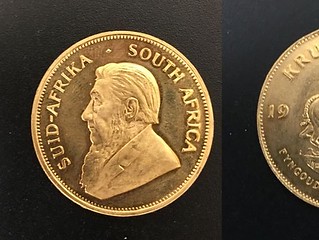 The Salvation Army confirmed that a gold 1979 Krugerrand coin was dropped in a kettle at the Walmart on Kietzke Lane in Reno last night.
The Salvation Army confirmed that a gold 1979 Krugerrand coin was dropped in a kettle at the Walmart on Kietzke Lane in Reno last night.
The one ounce gold coin is worth $1,255, said Allen Rowe, president of Northern Nevada Coin. The coin is not particularly rare but it is literally worth its weight in gold. The Krugerrand is gold bullion. In the 1970s mints produced millions of them, he said.
“I’m shocked and pleased to have this blessing in our red kettle.” Major Charles Fowler, Washoe County Salvation Army Reno corps coordinator, said in a news release. “We find unusual items in our kettles from time to time. Most have no value."
Some of those things are pocket lint, screws, washers, game tokens, foreign coins, Alcoholics Anonymous chips, batteries, angels, pills, gum wrappers, staples, earrings, women’s rings, bracelets, a Navy souvenir coin and keys.
"This one, however, is a tremendous boost to the bell ringing campaign," according to Fowler. "Whoever this donor is, I just want to say thanks for the helping us and this community."
To read the complete article, see:
Anonymous donor drops gold bullion in a Reno Salvation Army kettle
(http://www.rgj.com/story/news/2017/12/15/anonymous-donor-drops-gold-bullion-reno-salvation-army-kettle/956984001/)
2017 OXFORD NUMISMATIC SOCIETY CHRISTMAS CARD
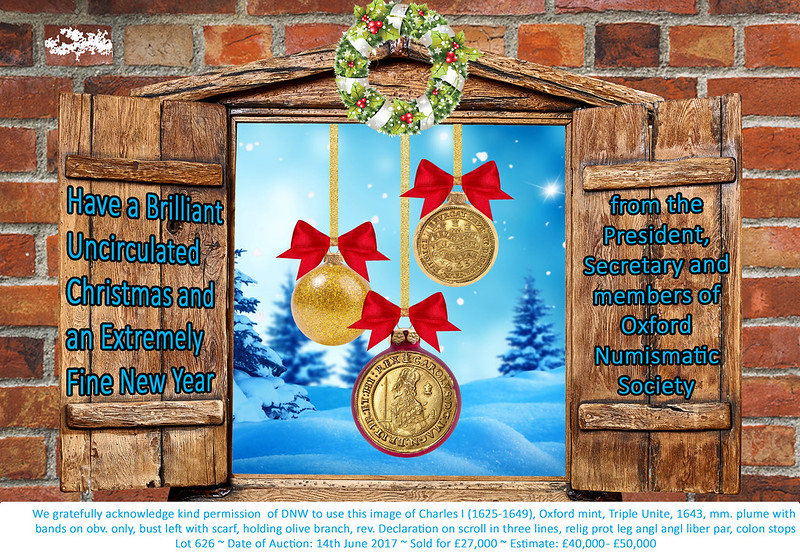
FEATURED WEB PAGE: AUSTRALIA WWII INTERNMENT TOKENS
This week's Featured Web Site is about Australia's WWII Internment Tokens.With increasing concerns as the pall of WWII settled over Europe, “enemy aliens” in Australia whose loyalty was suspect were removed to Internment Camps. The Camps initially housed immigrants from Germany, Italy and other axis-linked countries. They were subsequently joined by Japanese internees, and prisoners of war and internees transported from the Middle East, Pacific Islands, the Netherlands East Indies, the Straits Settlements, the United Kingdom and New Zealand.
For security reasons, tokens were used in Australian and New Zealand World War II Internment Camps in place of the normal currency. They were introduced in Australia, probably in 1943, to replace paper canteen coupons.
Two Melbourne firms manufactured the tokens: Arendsen & Sons made five shillings, two shillings and one penny pieces; while KG Luke & Co produced the one shilling and three pence tokens that completed the series. Other than the pennies, which were struck in brass (with a few rare copper or bronze trial or specimen strikes), the tokens were struck in copperi.
The tokens were holed in the centre, clearly distinguishing them from the circulating currency. Wreaths, ornamented with berries and gum nuts, surround the centre holes together with the inscriptions of “INTERNMENT CAMPS” on the obverse and the denomination on the reverse. The Luke tokens have finer design details than the Arendsen pieces.

www.sterlingcurrency.com.au/research/
background-australias-wwii-internment-tokens

